Air Asia Strategic Management Analysis
VerifiedAdded on 2020/10/22
|25
|4624
|95
AI Summary
This assignment analyzes the strategic management of Air Asia, a low-cost airline that has experienced significant growth and success. The report examines the company's leadership style, particularly Tony Fernandes' approach, which has contributed to its expansion. It also discusses the importance of effective strategies, such as competitive pricing and strong marketing, in achieving business success. Additionally, the report highlights the value generated by Air Asia through activities like inbound and outbound logistics, sales, and services.
Contribute Materials
Your contribution can guide someone’s learning journey. Share your
documents today.
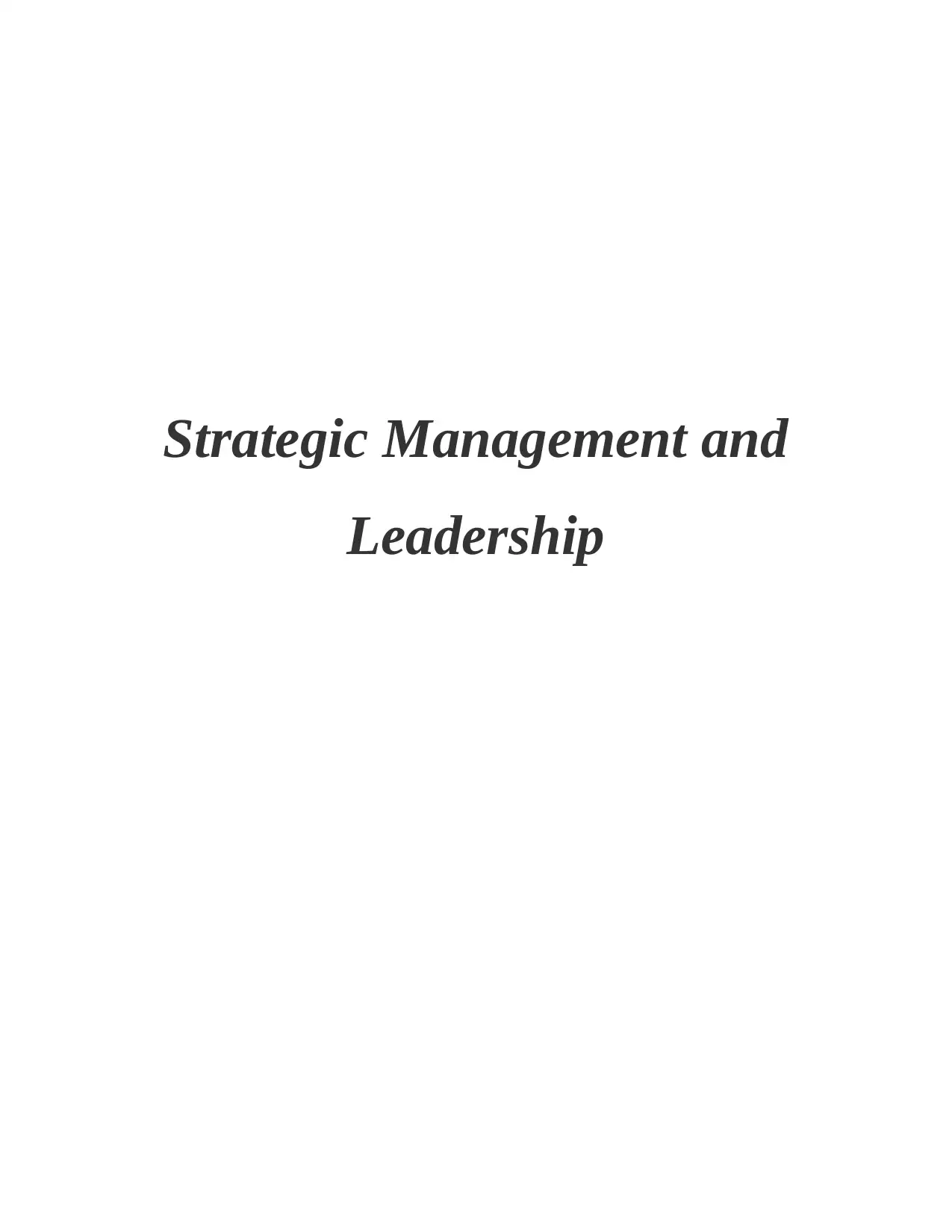
Strategic Management and
Leadership
Leadership
Secure Best Marks with AI Grader
Need help grading? Try our AI Grader for instant feedback on your assignments.
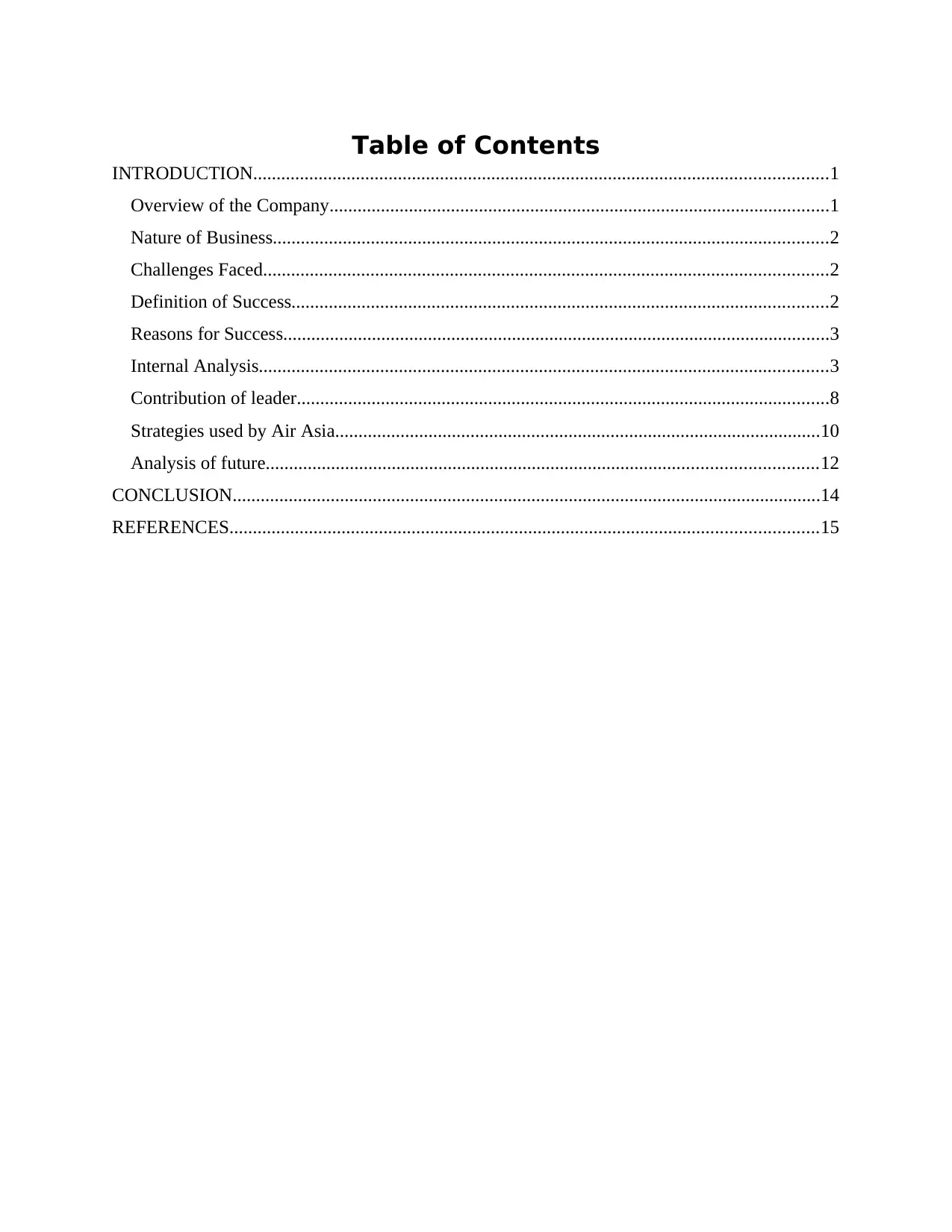
Table of Contents
INTRODUCTION...........................................................................................................................1
Overview of the Company...........................................................................................................1
Nature of Business.......................................................................................................................2
Challenges Faced.........................................................................................................................2
Definition of Success...................................................................................................................2
Reasons for Success.....................................................................................................................3
Internal Analysis..........................................................................................................................3
Contribution of leader..................................................................................................................8
Strategies used by Air Asia........................................................................................................10
Analysis of future......................................................................................................................12
CONCLUSION..............................................................................................................................14
REFERENCES..............................................................................................................................15
INTRODUCTION...........................................................................................................................1
Overview of the Company...........................................................................................................1
Nature of Business.......................................................................................................................2
Challenges Faced.........................................................................................................................2
Definition of Success...................................................................................................................2
Reasons for Success.....................................................................................................................3
Internal Analysis..........................................................................................................................3
Contribution of leader..................................................................................................................8
Strategies used by Air Asia........................................................................................................10
Analysis of future......................................................................................................................12
CONCLUSION..............................................................................................................................14
REFERENCES..............................................................................................................................15
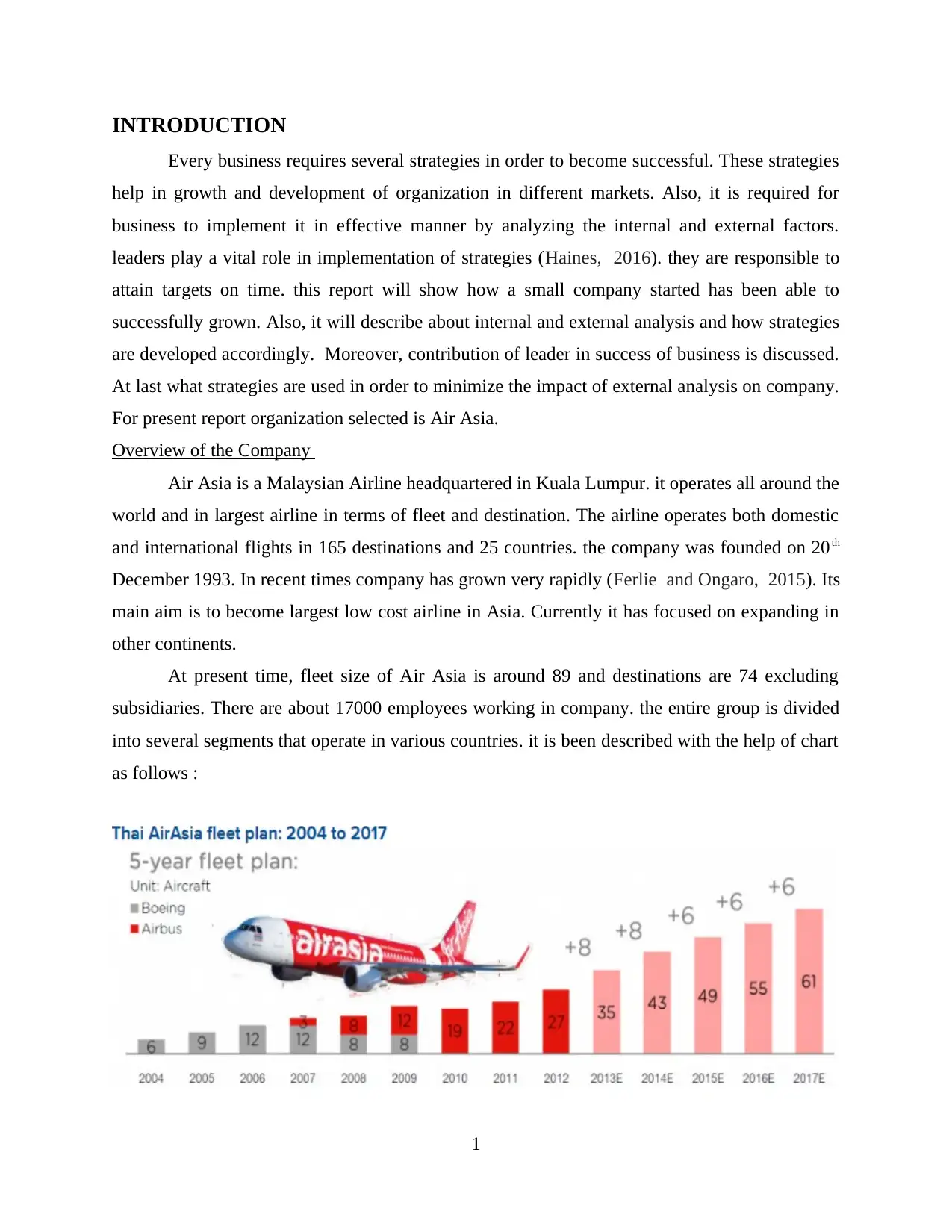
INTRODUCTION
Every business requires several strategies in order to become successful. These strategies
help in growth and development of organization in different markets. Also, it is required for
business to implement it in effective manner by analyzing the internal and external factors.
leaders play a vital role in implementation of strategies (Haines, 2016). they are responsible to
attain targets on time. this report will show how a small company started has been able to
successfully grown. Also, it will describe about internal and external analysis and how strategies
are developed accordingly. Moreover, contribution of leader in success of business is discussed.
At last what strategies are used in order to minimize the impact of external analysis on company.
For present report organization selected is Air Asia.
Overview of the Company
Air Asia is a Malaysian Airline headquartered in Kuala Lumpur. it operates all around the
world and in largest airline in terms of fleet and destination. The airline operates both domestic
and international flights in 165 destinations and 25 countries. the company was founded on 20th
December 1993. In recent times company has grown very rapidly (Ferlie and Ongaro, 2015). Its
main aim is to become largest low cost airline in Asia. Currently it has focused on expanding in
other continents.
At present time, fleet size of Air Asia is around 89 and destinations are 74 excluding
subsidiaries. There are about 17000 employees working in company. the entire group is divided
into several segments that operate in various countries. it is been described with the help of chart
as follows :
1
Every business requires several strategies in order to become successful. These strategies
help in growth and development of organization in different markets. Also, it is required for
business to implement it in effective manner by analyzing the internal and external factors.
leaders play a vital role in implementation of strategies (Haines, 2016). they are responsible to
attain targets on time. this report will show how a small company started has been able to
successfully grown. Also, it will describe about internal and external analysis and how strategies
are developed accordingly. Moreover, contribution of leader in success of business is discussed.
At last what strategies are used in order to minimize the impact of external analysis on company.
For present report organization selected is Air Asia.
Overview of the Company
Air Asia is a Malaysian Airline headquartered in Kuala Lumpur. it operates all around the
world and in largest airline in terms of fleet and destination. The airline operates both domestic
and international flights in 165 destinations and 25 countries. the company was founded on 20th
December 1993. In recent times company has grown very rapidly (Ferlie and Ongaro, 2015). Its
main aim is to become largest low cost airline in Asia. Currently it has focused on expanding in
other continents.
At present time, fleet size of Air Asia is around 89 and destinations are 74 excluding
subsidiaries. There are about 17000 employees working in company. the entire group is divided
into several segments that operate in various countries. it is been described with the help of chart
as follows :
1
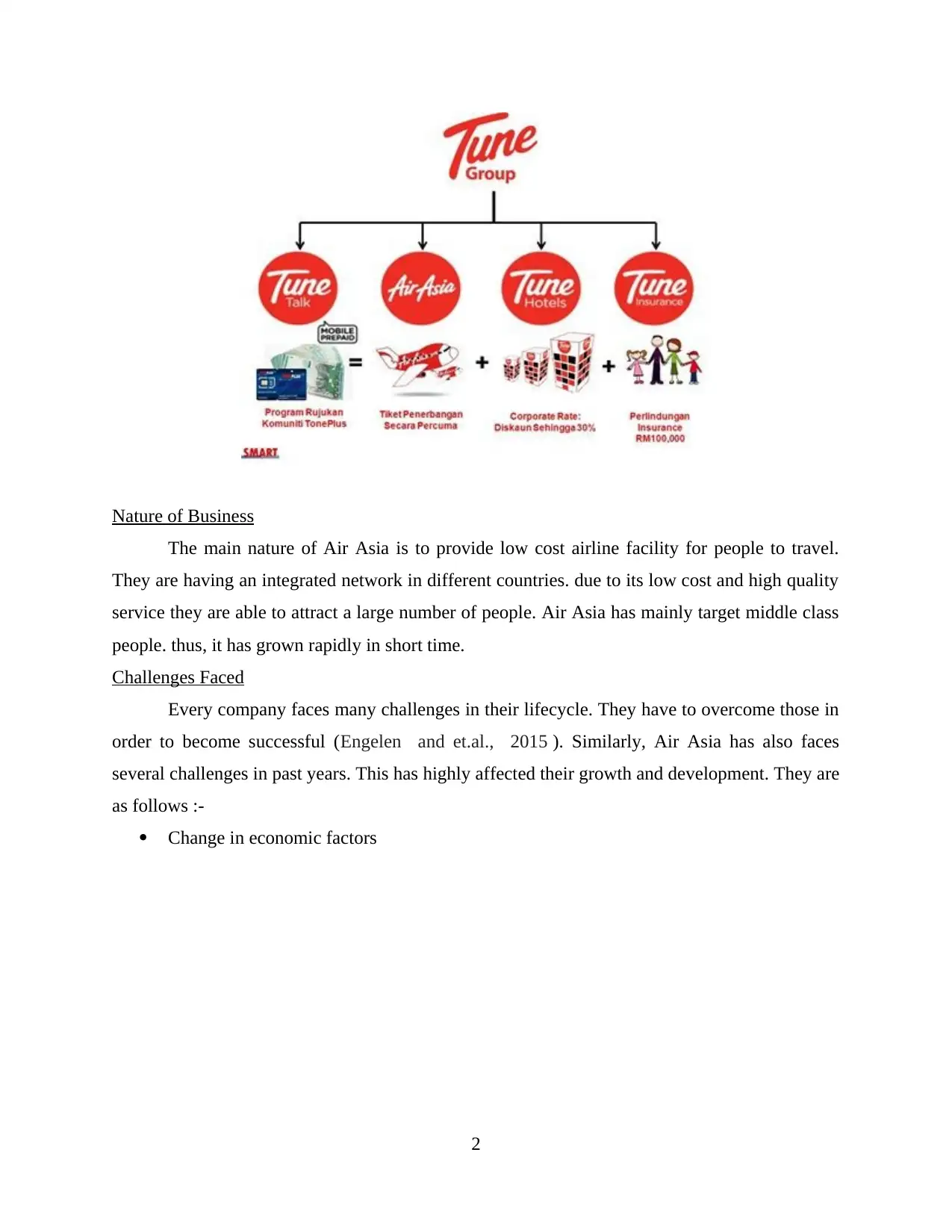
Nature of Business
The main nature of Air Asia is to provide low cost airline facility for people to travel.
They are having an integrated network in different countries. due to its low cost and high quality
service they are able to attract a large number of people. Air Asia has mainly target middle class
people. thus, it has grown rapidly in short time.
Challenges Faced
Every company faces many challenges in their lifecycle. They have to overcome those in
order to become successful (Engelen and et.al., 2015 ). Similarly, Air Asia has also faces
several challenges in past years. This has highly affected their growth and development. They are
as follows :-
Change in economic factors
2
The main nature of Air Asia is to provide low cost airline facility for people to travel.
They are having an integrated network in different countries. due to its low cost and high quality
service they are able to attract a large number of people. Air Asia has mainly target middle class
people. thus, it has grown rapidly in short time.
Challenges Faced
Every company faces many challenges in their lifecycle. They have to overcome those in
order to become successful (Engelen and et.al., 2015 ). Similarly, Air Asia has also faces
several challenges in past years. This has highly affected their growth and development. They are
as follows :-
Change in economic factors
2
Secure Best Marks with AI Grader
Need help grading? Try our AI Grader for instant feedback on your assignments.
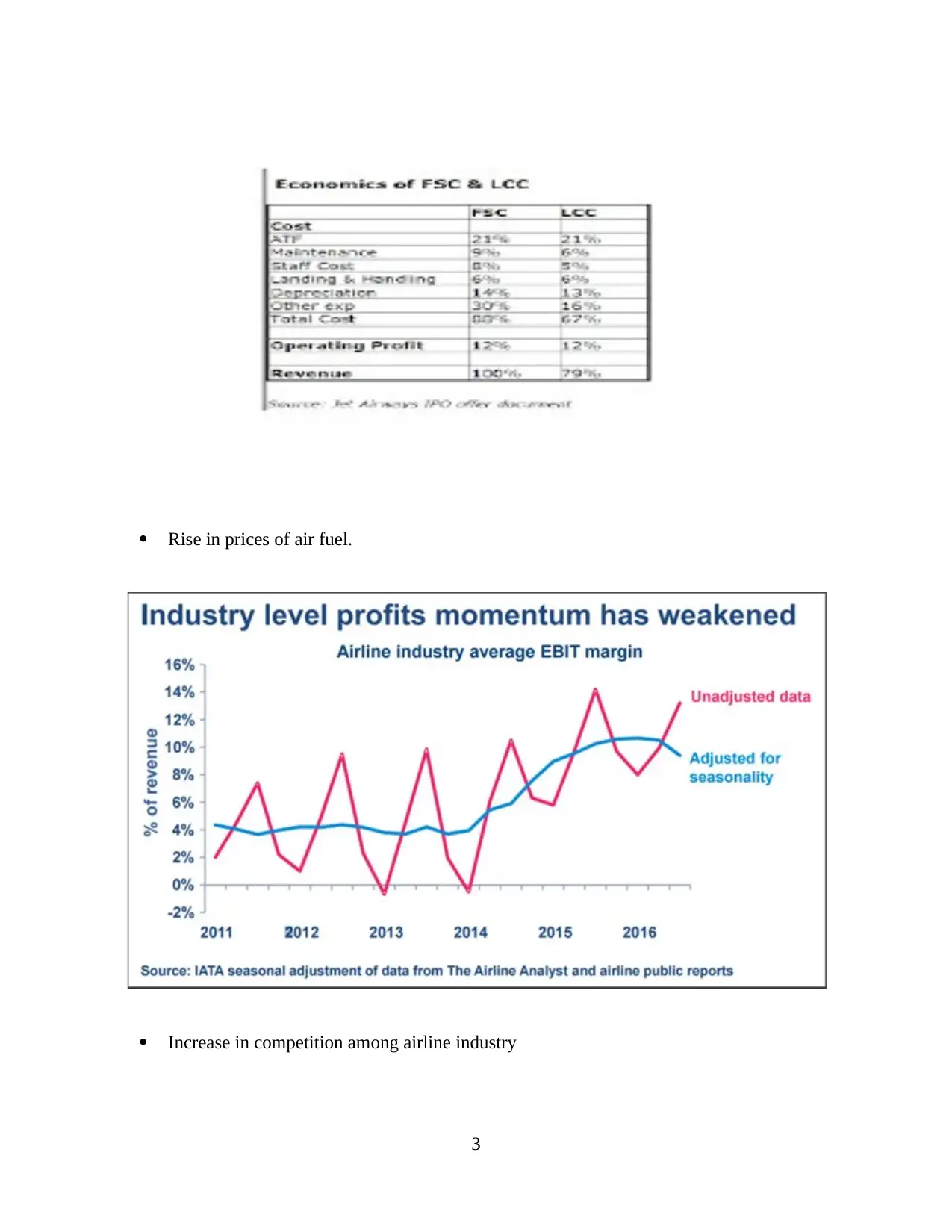
Rise in prices of air fuel.
Increase in competition among airline industry
3
Increase in competition among airline industry
3
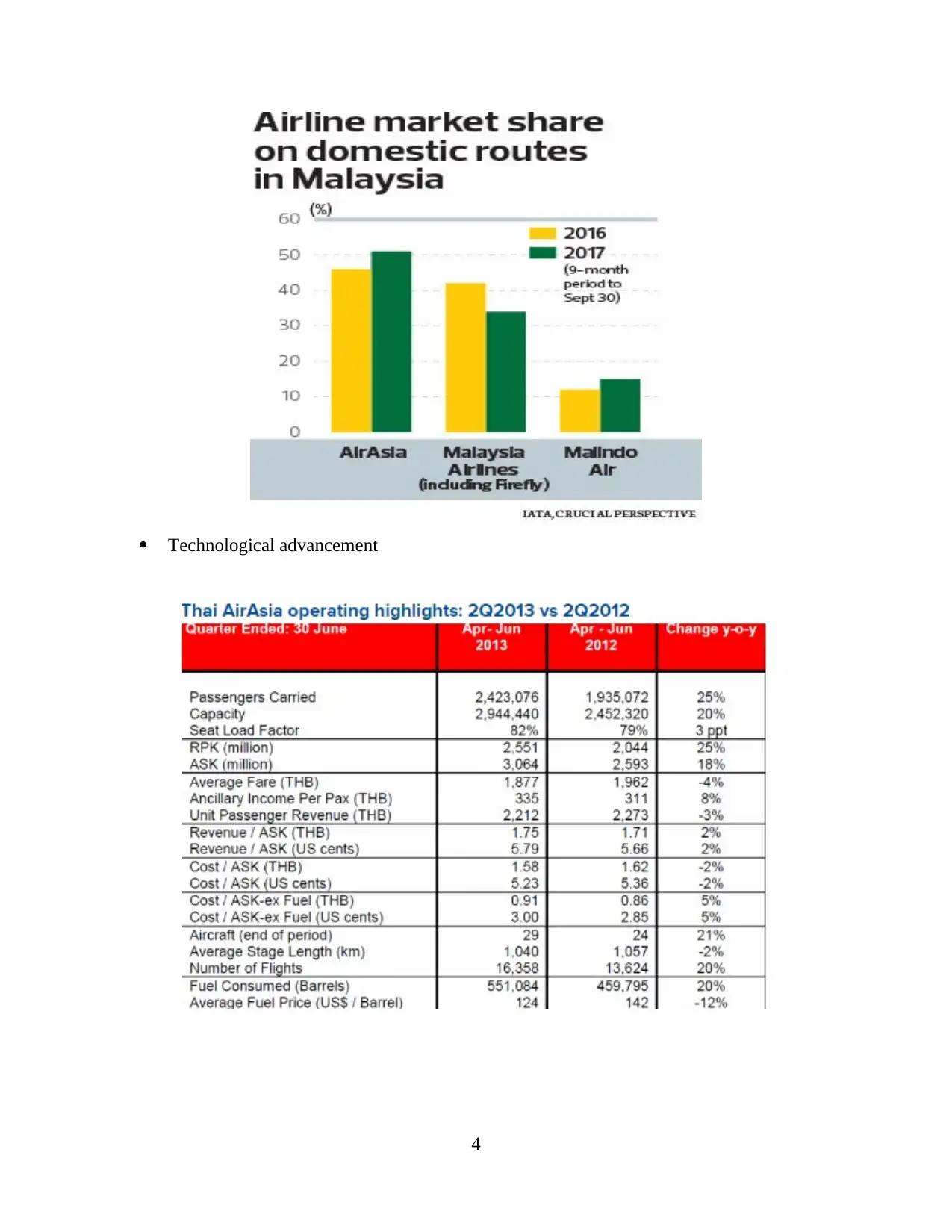
Technological advancement
4
4
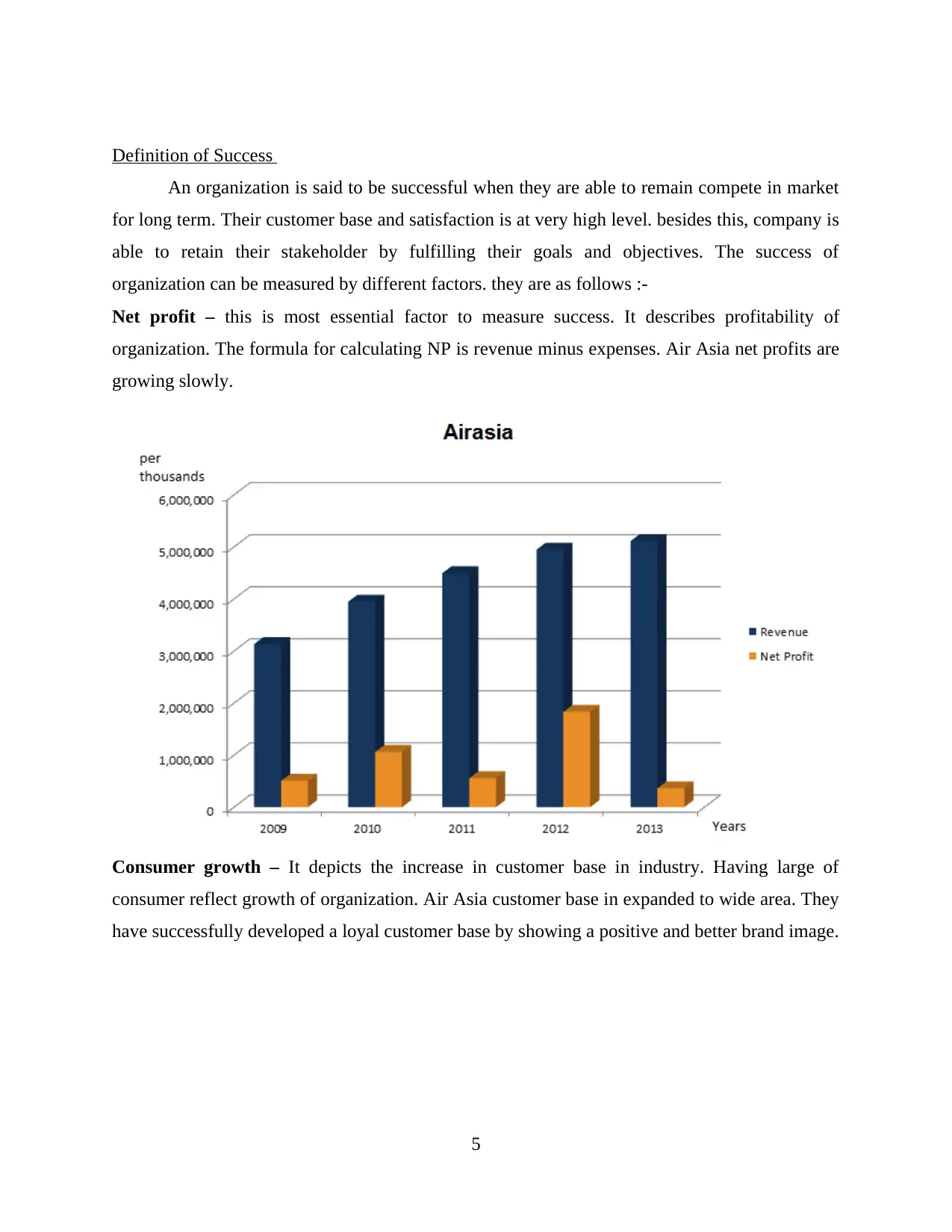
Definition of Success
An organization is said to be successful when they are able to remain compete in market
for long term. Their customer base and satisfaction is at very high level. besides this, company is
able to retain their stakeholder by fulfilling their goals and objectives. The success of
organization can be measured by different factors. they are as follows :-
Net profit – this is most essential factor to measure success. It describes profitability of
organization. The formula for calculating NP is revenue minus expenses. Air Asia net profits are
growing slowly.
Consumer growth – It depicts the increase in customer base in industry. Having large of
consumer reflect growth of organization. Air Asia customer base in expanded to wide area. They
have successfully developed a loyal customer base by showing a positive and better brand image.
5
An organization is said to be successful when they are able to remain compete in market
for long term. Their customer base and satisfaction is at very high level. besides this, company is
able to retain their stakeholder by fulfilling their goals and objectives. The success of
organization can be measured by different factors. they are as follows :-
Net profit – this is most essential factor to measure success. It describes profitability of
organization. The formula for calculating NP is revenue minus expenses. Air Asia net profits are
growing slowly.
Consumer growth – It depicts the increase in customer base in industry. Having large of
consumer reflect growth of organization. Air Asia customer base in expanded to wide area. They
have successfully developed a loyal customer base by showing a positive and better brand image.
5
Paraphrase This Document
Need a fresh take? Get an instant paraphrase of this document with our AI Paraphraser
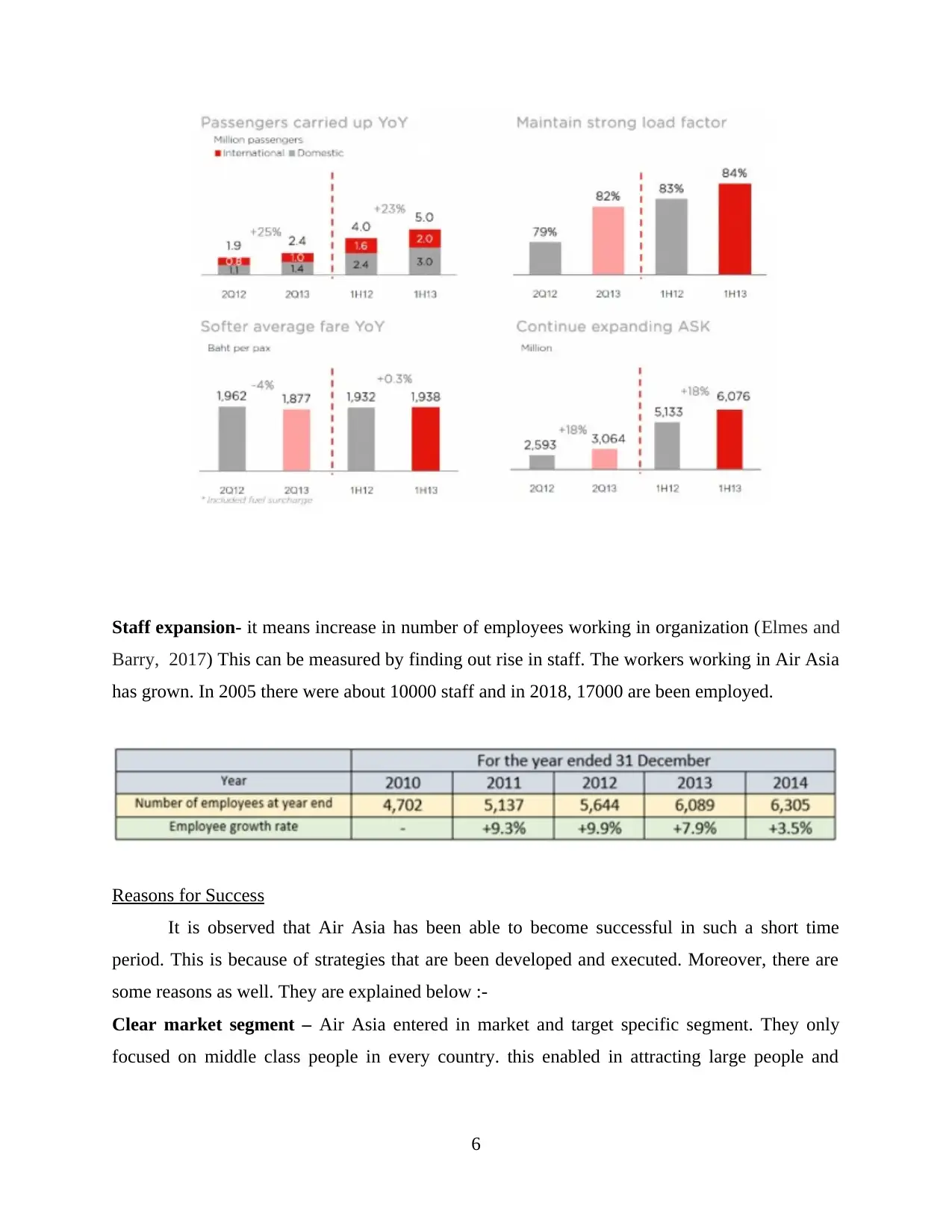
Staff expansion- it means increase in number of employees working in organization (Elmes and
Barry, 2017) This can be measured by finding out rise in staff. The workers working in Air Asia
has grown. In 2005 there were about 10000 staff and in 2018, 17000 are been employed.
Reasons for Success
It is observed that Air Asia has been able to become successful in such a short time
period. This is because of strategies that are been developed and executed. Moreover, there are
some reasons as well. They are explained below :-
Clear market segment – Air Asia entered in market and target specific segment. They only
focused on middle class people in every country. this enabled in attracting large people and
6
Barry, 2017) This can be measured by finding out rise in staff. The workers working in Air Asia
has grown. In 2005 there were about 10000 staff and in 2018, 17000 are been employed.
Reasons for Success
It is observed that Air Asia has been able to become successful in such a short time
period. This is because of strategies that are been developed and executed. Moreover, there are
some reasons as well. They are explained below :-
Clear market segment – Air Asia entered in market and target specific segment. They only
focused on middle class people in every country. this enabled in attracting large people and
6
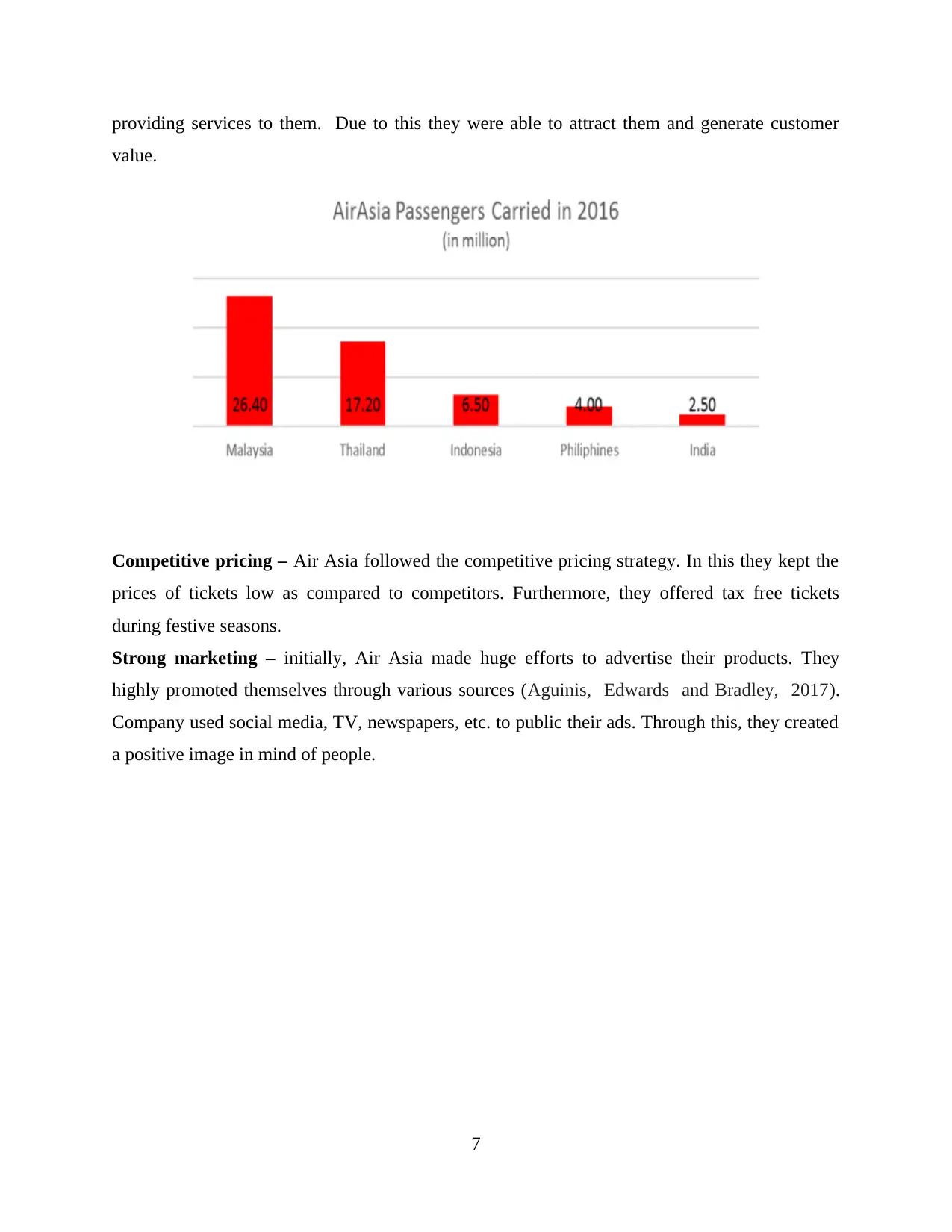
providing services to them. Due to this they were able to attract them and generate customer
value.
Competitive pricing – Air Asia followed the competitive pricing strategy. In this they kept the
prices of tickets low as compared to competitors. Furthermore, they offered tax free tickets
during festive seasons.
Strong marketing – initially, Air Asia made huge efforts to advertise their products. They
highly promoted themselves through various sources (Aguinis, Edwards and Bradley, 2017).
Company used social media, TV, newspapers, etc. to public their ads. Through this, they created
a positive image in mind of people.
7
value.
Competitive pricing – Air Asia followed the competitive pricing strategy. In this they kept the
prices of tickets low as compared to competitors. Furthermore, they offered tax free tickets
during festive seasons.
Strong marketing – initially, Air Asia made huge efforts to advertise their products. They
highly promoted themselves through various sources (Aguinis, Edwards and Bradley, 2017).
Company used social media, TV, newspapers, etc. to public their ads. Through this, they created
a positive image in mind of people.
7
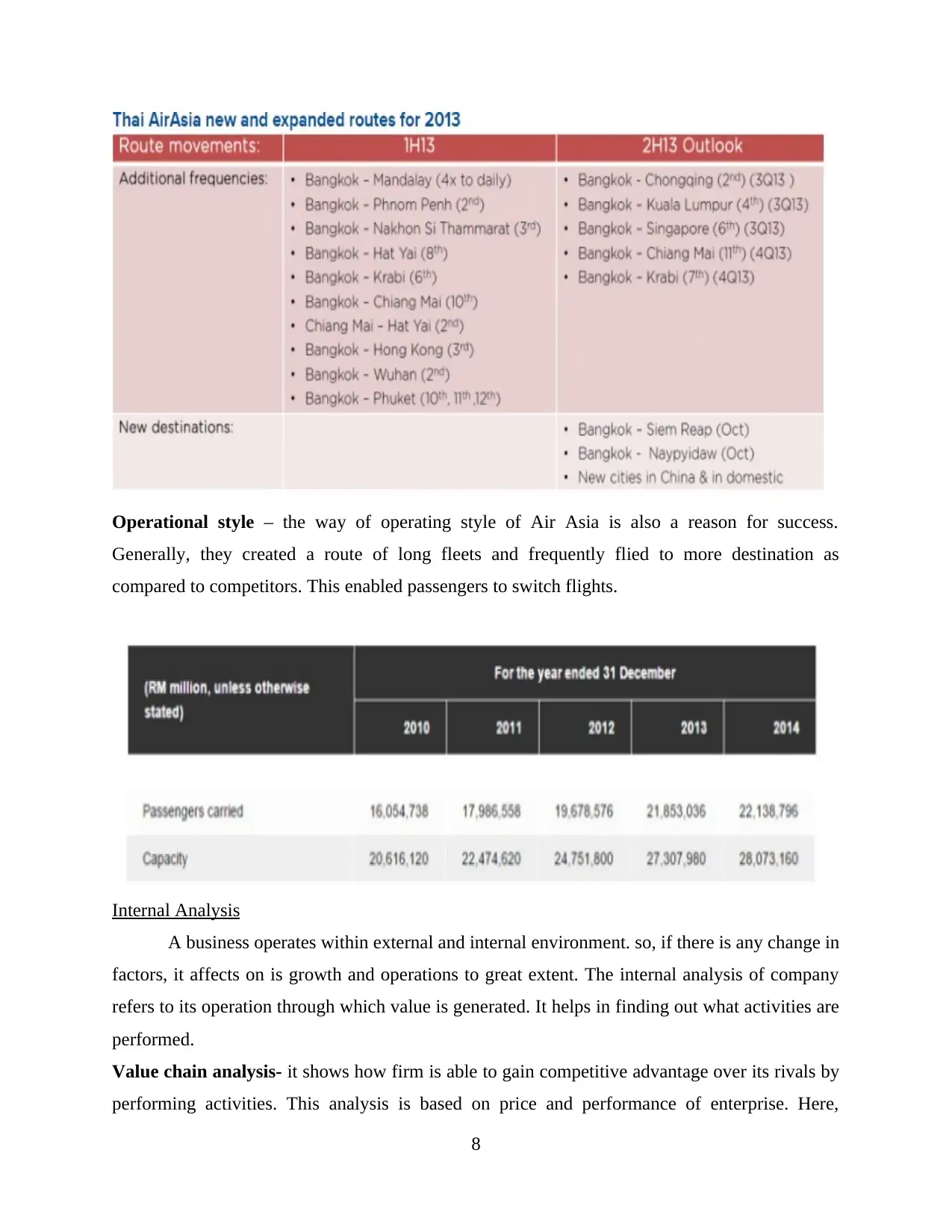
Operational style – the way of operating style of Air Asia is also a reason for success.
Generally, they created a route of long fleets and frequently flied to more destination as
compared to competitors. This enabled passengers to switch flights.
Internal Analysis
A business operates within external and internal environment. so, if there is any change in
factors, it affects on is growth and operations to great extent. The internal analysis of company
refers to its operation through which value is generated. It helps in finding out what activities are
performed.
Value chain analysis- it shows how firm is able to gain competitive advantage over its rivals by
performing activities. This analysis is based on price and performance of enterprise. Here,
8
Generally, they created a route of long fleets and frequently flied to more destination as
compared to competitors. This enabled passengers to switch flights.
Internal Analysis
A business operates within external and internal environment. so, if there is any change in
factors, it affects on is growth and operations to great extent. The internal analysis of company
refers to its operation through which value is generated. It helps in finding out what activities are
performed.
Value chain analysis- it shows how firm is able to gain competitive advantage over its rivals by
performing activities. This analysis is based on price and performance of enterprise. Here,
8
Secure Best Marks with AI Grader
Need help grading? Try our AI Grader for instant feedback on your assignments.
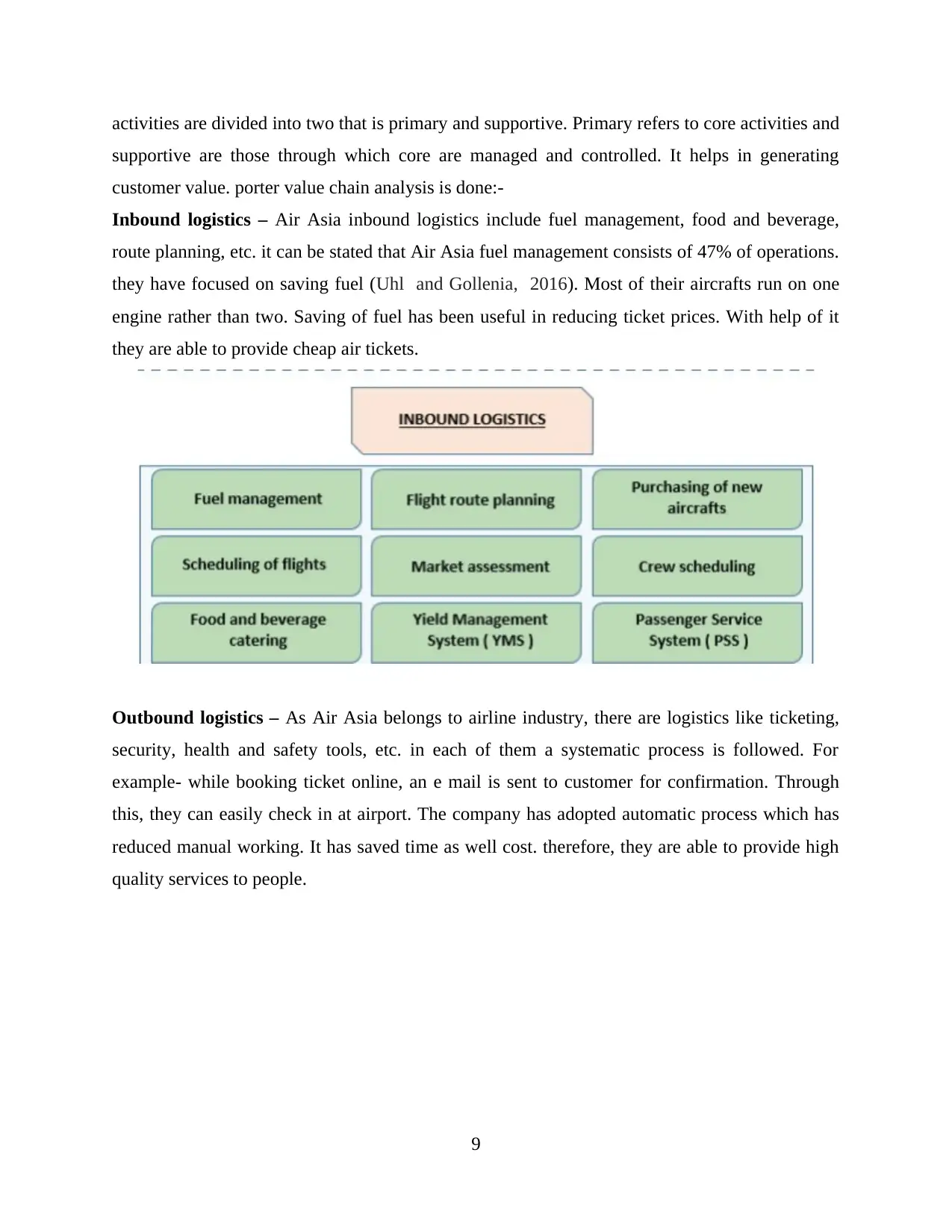
activities are divided into two that is primary and supportive. Primary refers to core activities and
supportive are those through which core are managed and controlled. It helps in generating
customer value. porter value chain analysis is done:-
Inbound logistics – Air Asia inbound logistics include fuel management, food and beverage,
route planning, etc. it can be stated that Air Asia fuel management consists of 47% of operations.
they have focused on saving fuel (Uhl and Gollenia, 2016). Most of their aircrafts run on one
engine rather than two. Saving of fuel has been useful in reducing ticket prices. With help of it
they are able to provide cheap air tickets.
Outbound logistics – As Air Asia belongs to airline industry, there are logistics like ticketing,
security, health and safety tools, etc. in each of them a systematic process is followed. For
example- while booking ticket online, an e mail is sent to customer for confirmation. Through
this, they can easily check in at airport. The company has adopted automatic process which has
reduced manual working. It has saved time as well cost. therefore, they are able to provide high
quality services to people.
9
supportive are those through which core are managed and controlled. It helps in generating
customer value. porter value chain analysis is done:-
Inbound logistics – Air Asia inbound logistics include fuel management, food and beverage,
route planning, etc. it can be stated that Air Asia fuel management consists of 47% of operations.
they have focused on saving fuel (Uhl and Gollenia, 2016). Most of their aircrafts run on one
engine rather than two. Saving of fuel has been useful in reducing ticket prices. With help of it
they are able to provide cheap air tickets.
Outbound logistics – As Air Asia belongs to airline industry, there are logistics like ticketing,
security, health and safety tools, etc. in each of them a systematic process is followed. For
example- while booking ticket online, an e mail is sent to customer for confirmation. Through
this, they can easily check in at airport. The company has adopted automatic process which has
reduced manual working. It has saved time as well cost. therefore, they are able to provide high
quality services to people.
9
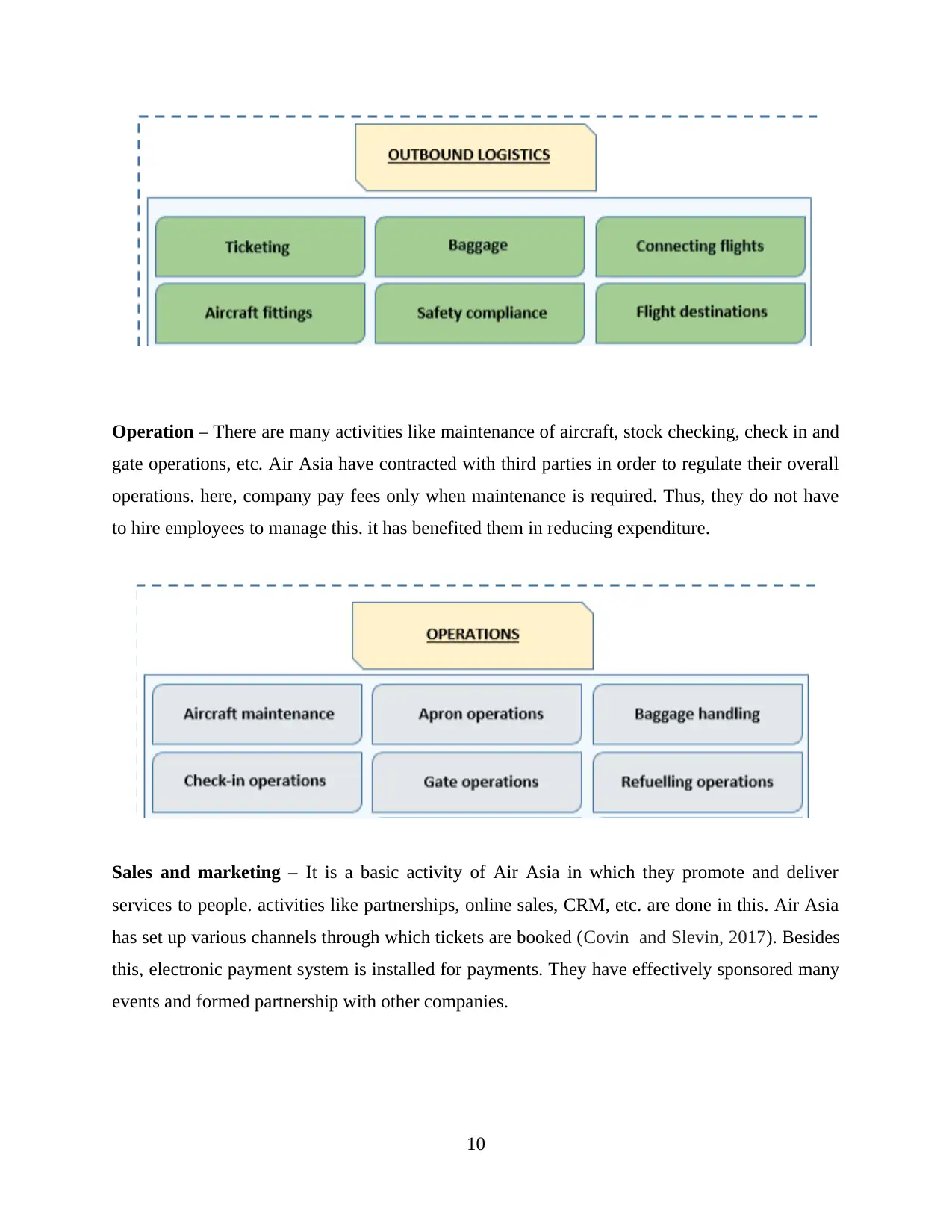
Operation – There are many activities like maintenance of aircraft, stock checking, check in and
gate operations, etc. Air Asia have contracted with third parties in order to regulate their overall
operations. here, company pay fees only when maintenance is required. Thus, they do not have
to hire employees to manage this. it has benefited them in reducing expenditure.
Sales and marketing – It is a basic activity of Air Asia in which they promote and deliver
services to people. activities like partnerships, online sales, CRM, etc. are done in this. Air Asia
has set up various channels through which tickets are booked (Covin and Slevin, 2017). Besides
this, electronic payment system is installed for payments. They have effectively sponsored many
events and formed partnership with other companies.
10
gate operations, etc. Air Asia have contracted with third parties in order to regulate their overall
operations. here, company pay fees only when maintenance is required. Thus, they do not have
to hire employees to manage this. it has benefited them in reducing expenditure.
Sales and marketing – It is a basic activity of Air Asia in which they promote and deliver
services to people. activities like partnerships, online sales, CRM, etc. are done in this. Air Asia
has set up various channels through which tickets are booked (Covin and Slevin, 2017). Besides
this, electronic payment system is installed for payments. They have effectively sponsored many
events and formed partnership with other companies.
10
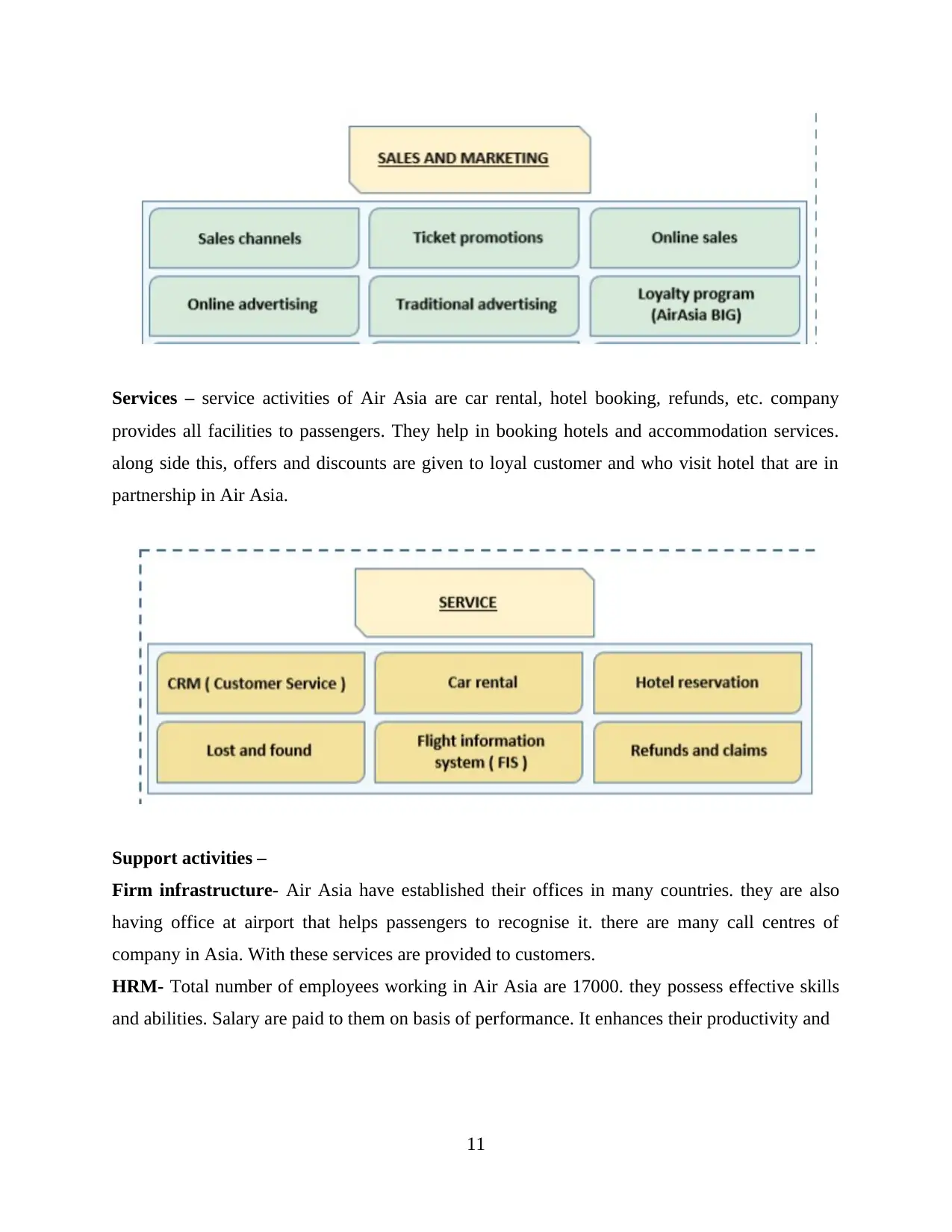
Services – service activities of Air Asia are car rental, hotel booking, refunds, etc. company
provides all facilities to passengers. They help in booking hotels and accommodation services.
along side this, offers and discounts are given to loyal customer and who visit hotel that are in
partnership in Air Asia.
Support activities –
Firm infrastructure- Air Asia have established their offices in many countries. they are also
having office at airport that helps passengers to recognise it. there are many call centres of
company in Asia. With these services are provided to customers.
HRM- Total number of employees working in Air Asia are 17000. they possess effective skills
and abilities. Salary are paid to them on basis of performance. It enhances their productivity and
11
provides all facilities to passengers. They help in booking hotels and accommodation services.
along side this, offers and discounts are given to loyal customer and who visit hotel that are in
partnership in Air Asia.
Support activities –
Firm infrastructure- Air Asia have established their offices in many countries. they are also
having office at airport that helps passengers to recognise it. there are many call centres of
company in Asia. With these services are provided to customers.
HRM- Total number of employees working in Air Asia are 17000. they possess effective skills
and abilities. Salary are paid to them on basis of performance. It enhances their productivity and
11
Paraphrase This Document
Need a fresh take? Get an instant paraphrase of this document with our AI Paraphraser
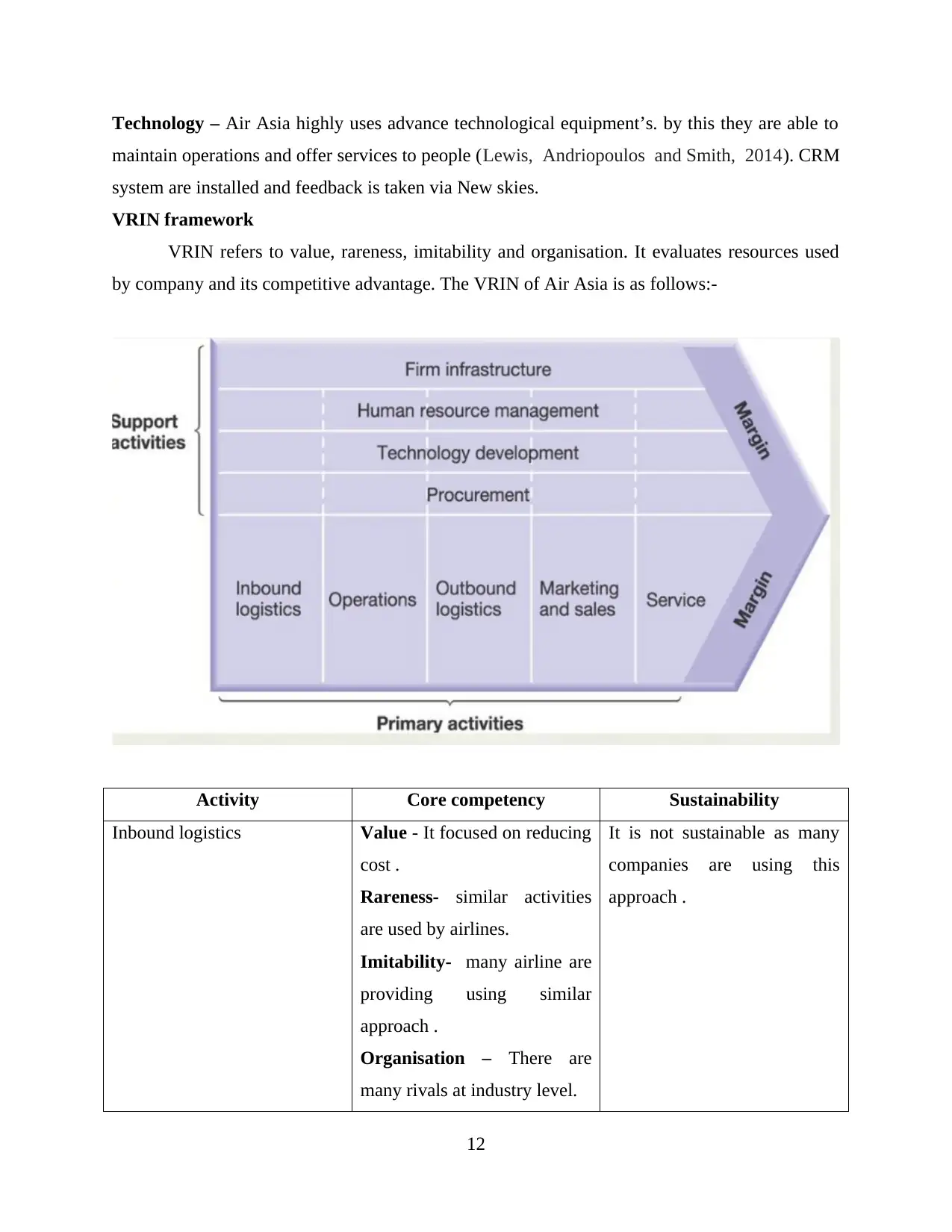
Technology – Air Asia highly uses advance technological equipment’s. by this they are able to
maintain operations and offer services to people (Lewis, Andriopoulos and Smith, 2014). CRM
system are installed and feedback is taken via New skies.
VRIN framework
VRIN refers to value, rareness, imitability and organisation. It evaluates resources used
by company and its competitive advantage. The VRIN of Air Asia is as follows:-
Activity Core competency Sustainability
Inbound logistics Value - It focused on reducing
cost .
Rareness- similar activities
are used by airlines.
Imitability- many airline are
providing using similar
approach .
Organisation – There are
many rivals at industry level.
It is not sustainable as many
companies are using this
approach .
12
maintain operations and offer services to people (Lewis, Andriopoulos and Smith, 2014). CRM
system are installed and feedback is taken via New skies.
VRIN framework
VRIN refers to value, rareness, imitability and organisation. It evaluates resources used
by company and its competitive advantage. The VRIN of Air Asia is as follows:-
Activity Core competency Sustainability
Inbound logistics Value - It focused on reducing
cost .
Rareness- similar activities
are used by airlines.
Imitability- many airline are
providing using similar
approach .
Organisation – There are
many rivals at industry level.
It is not sustainable as many
companies are using this
approach .
12
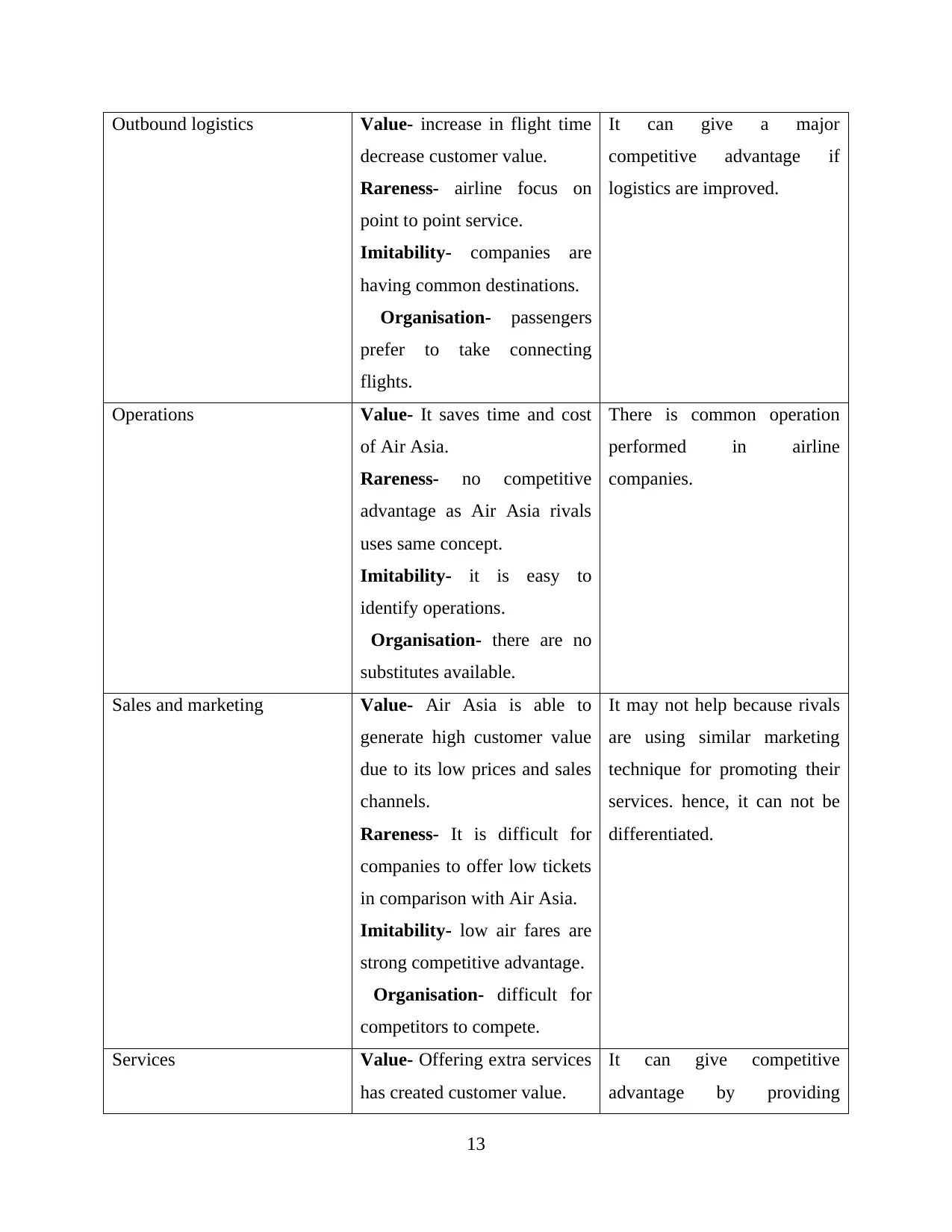
Outbound logistics Value- increase in flight time
decrease customer value.
Rareness- airline focus on
point to point service.
Imitability- companies are
having common destinations.
Organisation- passengers
prefer to take connecting
flights.
It can give a major
competitive advantage if
logistics are improved.
Operations Value- It saves time and cost
of Air Asia.
Rareness- no competitive
advantage as Air Asia rivals
uses same concept.
Imitability- it is easy to
identify operations.
Organisation- there are no
substitutes available.
There is common operation
performed in airline
companies.
Sales and marketing Value- Air Asia is able to
generate high customer value
due to its low prices and sales
channels.
Rareness- It is difficult for
companies to offer low tickets
in comparison with Air Asia.
Imitability- low air fares are
strong competitive advantage.
Organisation- difficult for
competitors to compete.
It may not help because rivals
are using similar marketing
technique for promoting their
services. hence, it can not be
differentiated.
Services Value- Offering extra services
has created customer value.
It can give competitive
advantage by providing
13
decrease customer value.
Rareness- airline focus on
point to point service.
Imitability- companies are
having common destinations.
Organisation- passengers
prefer to take connecting
flights.
It can give a major
competitive advantage if
logistics are improved.
Operations Value- It saves time and cost
of Air Asia.
Rareness- no competitive
advantage as Air Asia rivals
uses same concept.
Imitability- it is easy to
identify operations.
Organisation- there are no
substitutes available.
There is common operation
performed in airline
companies.
Sales and marketing Value- Air Asia is able to
generate high customer value
due to its low prices and sales
channels.
Rareness- It is difficult for
companies to offer low tickets
in comparison with Air Asia.
Imitability- low air fares are
strong competitive advantage.
Organisation- difficult for
competitors to compete.
It may not help because rivals
are using similar marketing
technique for promoting their
services. hence, it can not be
differentiated.
Services Value- Offering extra services
has created customer value.
It can give competitive
advantage by providing
13
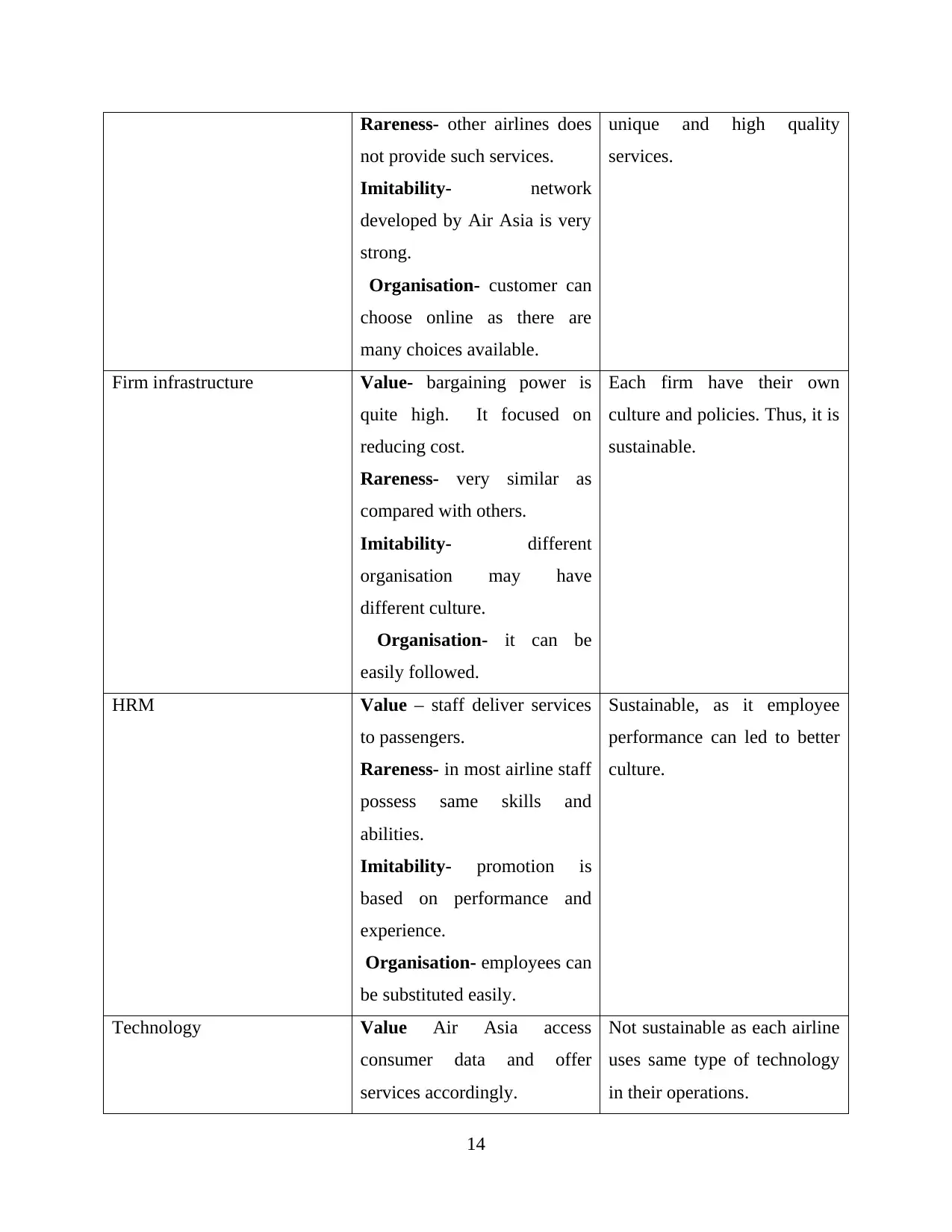
Rareness- other airlines does
not provide such services.
Imitability- network
developed by Air Asia is very
strong.
Organisation- customer can
choose online as there are
many choices available.
unique and high quality
services.
Firm infrastructure Value- bargaining power is
quite high. It focused on
reducing cost.
Rareness- very similar as
compared with others.
Imitability- different
organisation may have
different culture.
Organisation- it can be
easily followed.
Each firm have their own
culture and policies. Thus, it is
sustainable.
HRM Value – staff deliver services
to passengers.
Rareness- in most airline staff
possess same skills and
abilities.
Imitability- promotion is
based on performance and
experience.
Organisation- employees can
be substituted easily.
Sustainable, as it employee
performance can led to better
culture.
Technology Value Air Asia access
consumer data and offer
services accordingly.
Not sustainable as each airline
uses same type of technology
in their operations.
14
not provide such services.
Imitability- network
developed by Air Asia is very
strong.
Organisation- customer can
choose online as there are
many choices available.
unique and high quality
services.
Firm infrastructure Value- bargaining power is
quite high. It focused on
reducing cost.
Rareness- very similar as
compared with others.
Imitability- different
organisation may have
different culture.
Organisation- it can be
easily followed.
Each firm have their own
culture and policies. Thus, it is
sustainable.
HRM Value – staff deliver services
to passengers.
Rareness- in most airline staff
possess same skills and
abilities.
Imitability- promotion is
based on performance and
experience.
Organisation- employees can
be substituted easily.
Sustainable, as it employee
performance can led to better
culture.
Technology Value Air Asia access
consumer data and offer
services accordingly.
Not sustainable as each airline
uses same type of technology
in their operations.
14
Secure Best Marks with AI Grader
Need help grading? Try our AI Grader for instant feedback on your assignments.
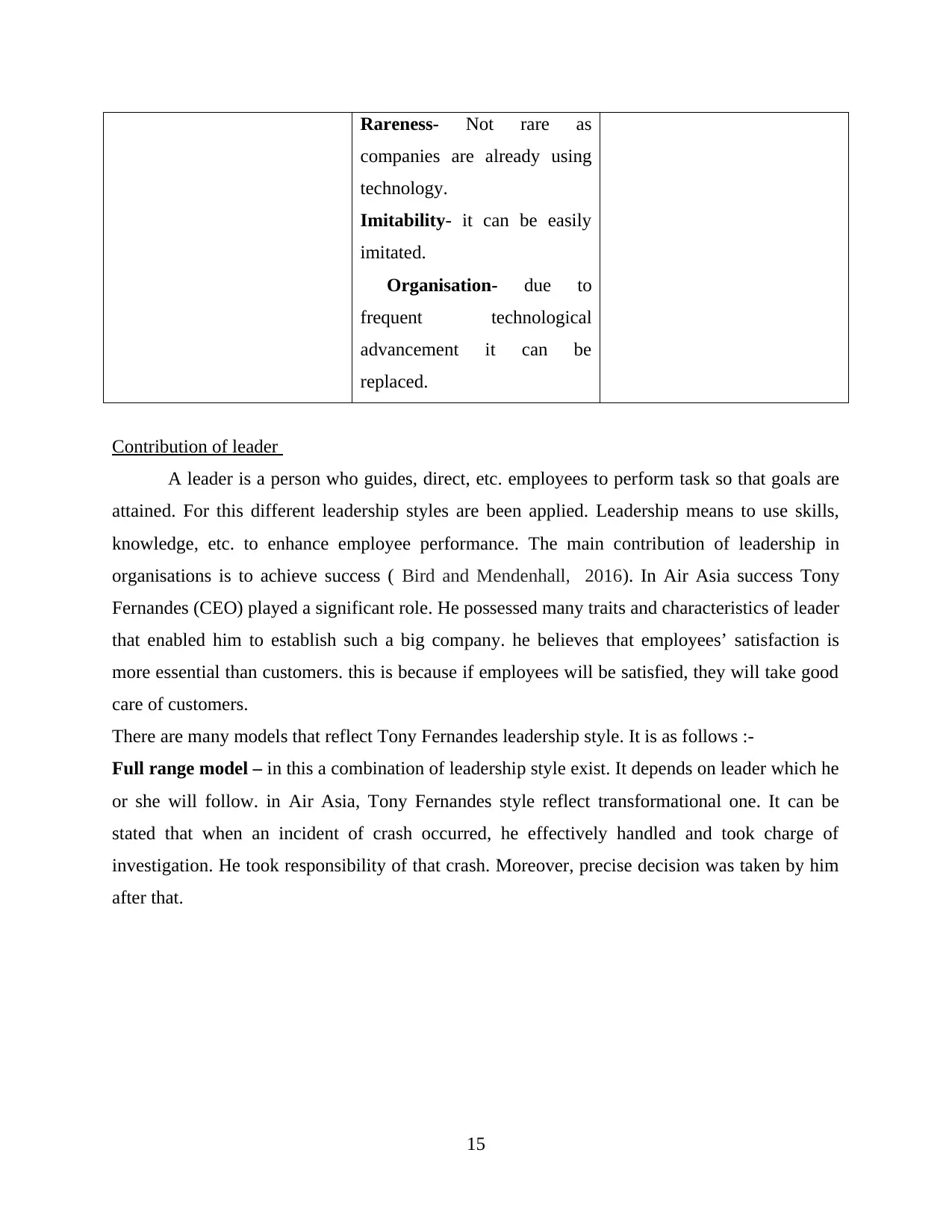
Rareness- Not rare as
companies are already using
technology.
Imitability- it can be easily
imitated.
Organisation- due to
frequent technological
advancement it can be
replaced.
Contribution of leader
A leader is a person who guides, direct, etc. employees to perform task so that goals are
attained. For this different leadership styles are been applied. Leadership means to use skills,
knowledge, etc. to enhance employee performance. The main contribution of leadership in
organisations is to achieve success ( Bird and Mendenhall, 2016). In Air Asia success Tony
Fernandes (CEO) played a significant role. He possessed many traits and characteristics of leader
that enabled him to establish such a big company. he believes that employees’ satisfaction is
more essential than customers. this is because if employees will be satisfied, they will take good
care of customers.
There are many models that reflect Tony Fernandes leadership style. It is as follows :-
Full range model – in this a combination of leadership style exist. It depends on leader which he
or she will follow. in Air Asia, Tony Fernandes style reflect transformational one. It can be
stated that when an incident of crash occurred, he effectively handled and took charge of
investigation. He took responsibility of that crash. Moreover, precise decision was taken by him
after that.
15
companies are already using
technology.
Imitability- it can be easily
imitated.
Organisation- due to
frequent technological
advancement it can be
replaced.
Contribution of leader
A leader is a person who guides, direct, etc. employees to perform task so that goals are
attained. For this different leadership styles are been applied. Leadership means to use skills,
knowledge, etc. to enhance employee performance. The main contribution of leadership in
organisations is to achieve success ( Bird and Mendenhall, 2016). In Air Asia success Tony
Fernandes (CEO) played a significant role. He possessed many traits and characteristics of leader
that enabled him to establish such a big company. he believes that employees’ satisfaction is
more essential than customers. this is because if employees will be satisfied, they will take good
care of customers.
There are many models that reflect Tony Fernandes leadership style. It is as follows :-
Full range model – in this a combination of leadership style exist. It depends on leader which he
or she will follow. in Air Asia, Tony Fernandes style reflect transformational one. It can be
stated that when an incident of crash occurred, he effectively handled and took charge of
investigation. He took responsibility of that crash. Moreover, precise decision was taken by him
after that.
15
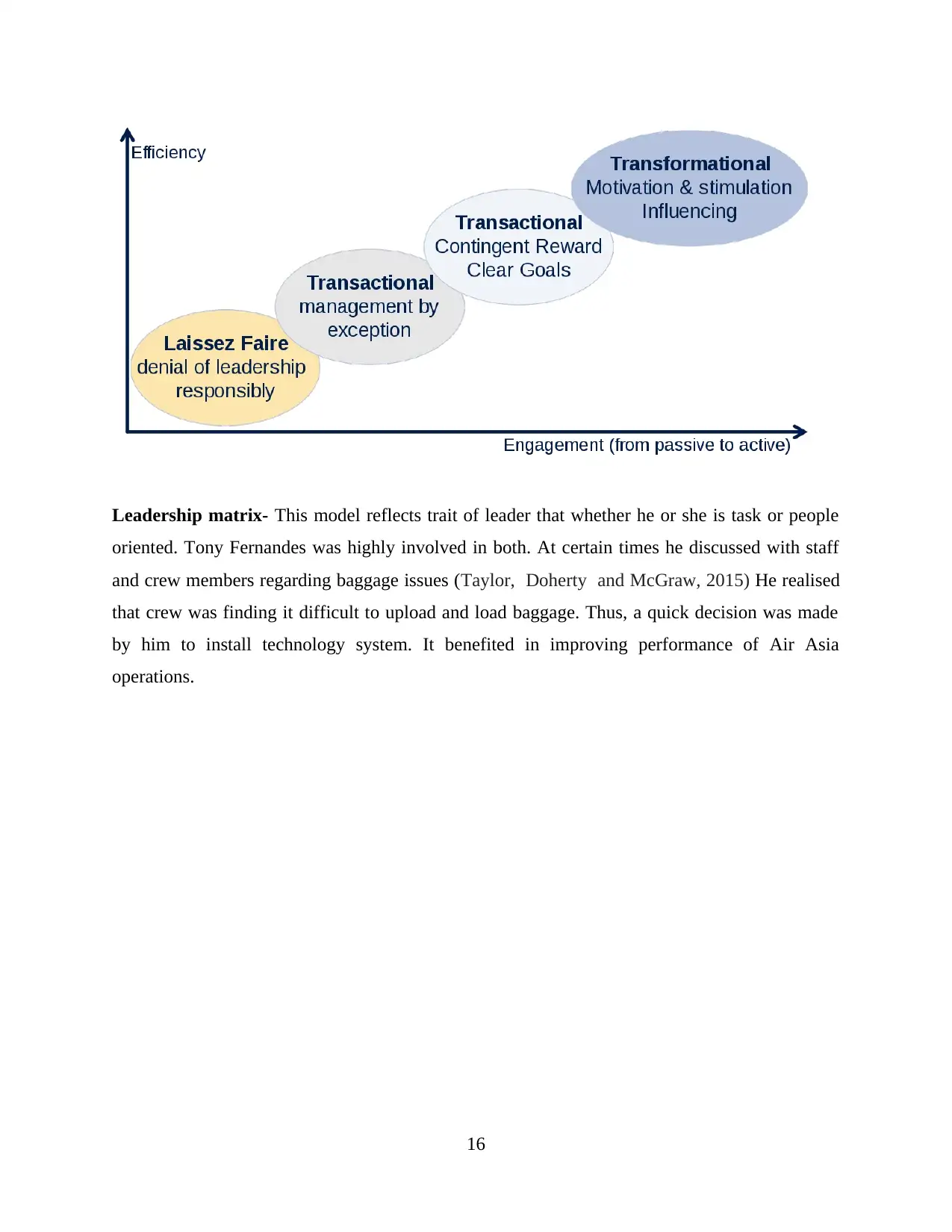
Leadership matrix- This model reflects trait of leader that whether he or she is task or people
oriented. Tony Fernandes was highly involved in both. At certain times he discussed with staff
and crew members regarding baggage issues (Taylor, Doherty and McGraw, 2015) He realised
that crew was finding it difficult to upload and load baggage. Thus, a quick decision was made
by him to install technology system. It benefited in improving performance of Air Asia
operations.
16
oriented. Tony Fernandes was highly involved in both. At certain times he discussed with staff
and crew members regarding baggage issues (Taylor, Doherty and McGraw, 2015) He realised
that crew was finding it difficult to upload and load baggage. Thus, a quick decision was made
by him to install technology system. It benefited in improving performance of Air Asia
operations.
16
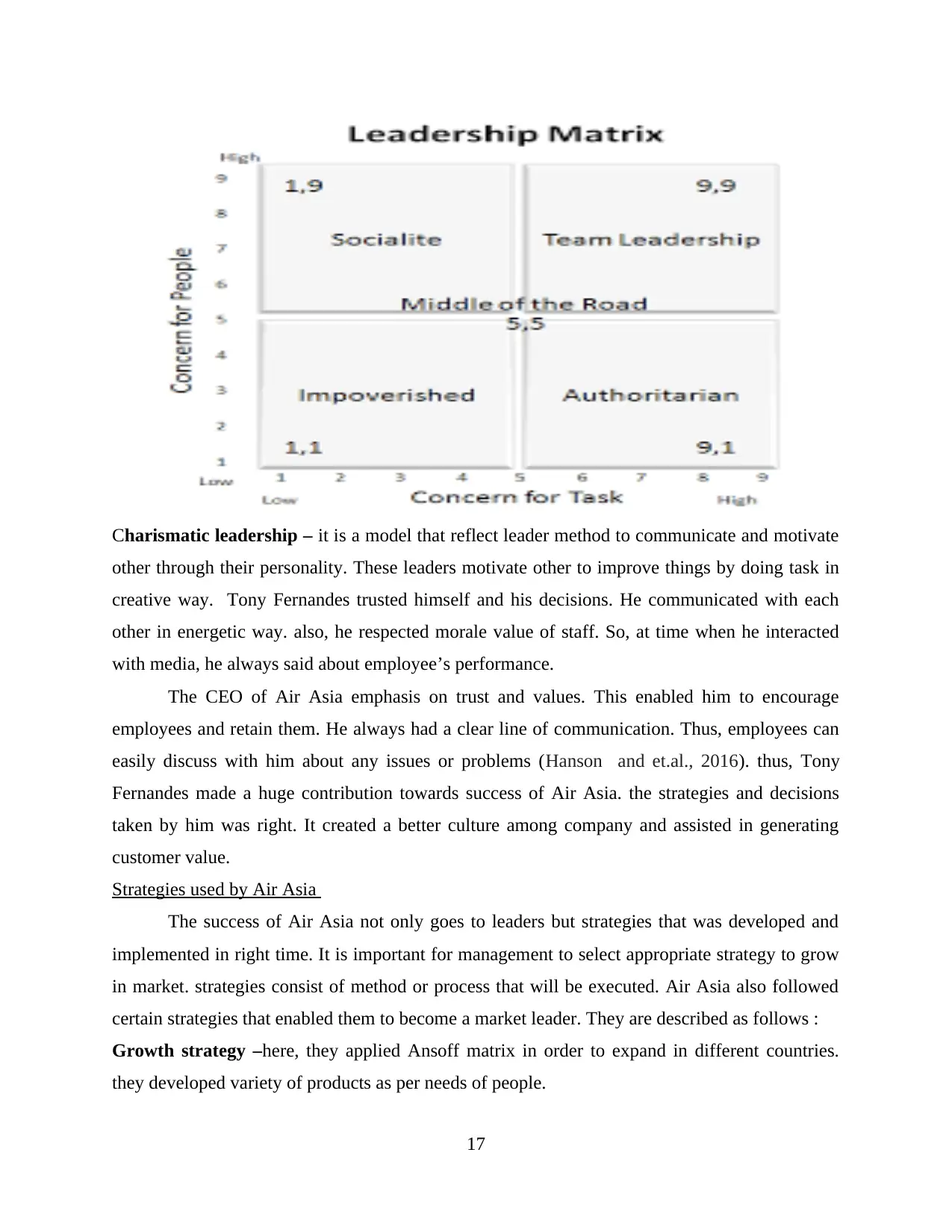
Charismatic leadership – it is a model that reflect leader method to communicate and motivate
other through their personality. These leaders motivate other to improve things by doing task in
creative way. Tony Fernandes trusted himself and his decisions. He communicated with each
other in energetic way. also, he respected morale value of staff. So, at time when he interacted
with media, he always said about employee’s performance.
The CEO of Air Asia emphasis on trust and values. This enabled him to encourage
employees and retain them. He always had a clear line of communication. Thus, employees can
easily discuss with him about any issues or problems (Hanson and et.al., 2016). thus, Tony
Fernandes made a huge contribution towards success of Air Asia. the strategies and decisions
taken by him was right. It created a better culture among company and assisted in generating
customer value.
Strategies used by Air Asia
The success of Air Asia not only goes to leaders but strategies that was developed and
implemented in right time. It is important for management to select appropriate strategy to grow
in market. strategies consist of method or process that will be executed. Air Asia also followed
certain strategies that enabled them to become a market leader. They are described as follows :
Growth strategy –here, they applied Ansoff matrix in order to expand in different countries.
they developed variety of products as per needs of people.
17
other through their personality. These leaders motivate other to improve things by doing task in
creative way. Tony Fernandes trusted himself and his decisions. He communicated with each
other in energetic way. also, he respected morale value of staff. So, at time when he interacted
with media, he always said about employee’s performance.
The CEO of Air Asia emphasis on trust and values. This enabled him to encourage
employees and retain them. He always had a clear line of communication. Thus, employees can
easily discuss with him about any issues or problems (Hanson and et.al., 2016). thus, Tony
Fernandes made a huge contribution towards success of Air Asia. the strategies and decisions
taken by him was right. It created a better culture among company and assisted in generating
customer value.
Strategies used by Air Asia
The success of Air Asia not only goes to leaders but strategies that was developed and
implemented in right time. It is important for management to select appropriate strategy to grow
in market. strategies consist of method or process that will be executed. Air Asia also followed
certain strategies that enabled them to become a market leader. They are described as follows :
Growth strategy –here, they applied Ansoff matrix in order to expand in different countries.
they developed variety of products as per needs of people.
17
Paraphrase This Document
Need a fresh take? Get an instant paraphrase of this document with our AI Paraphraser
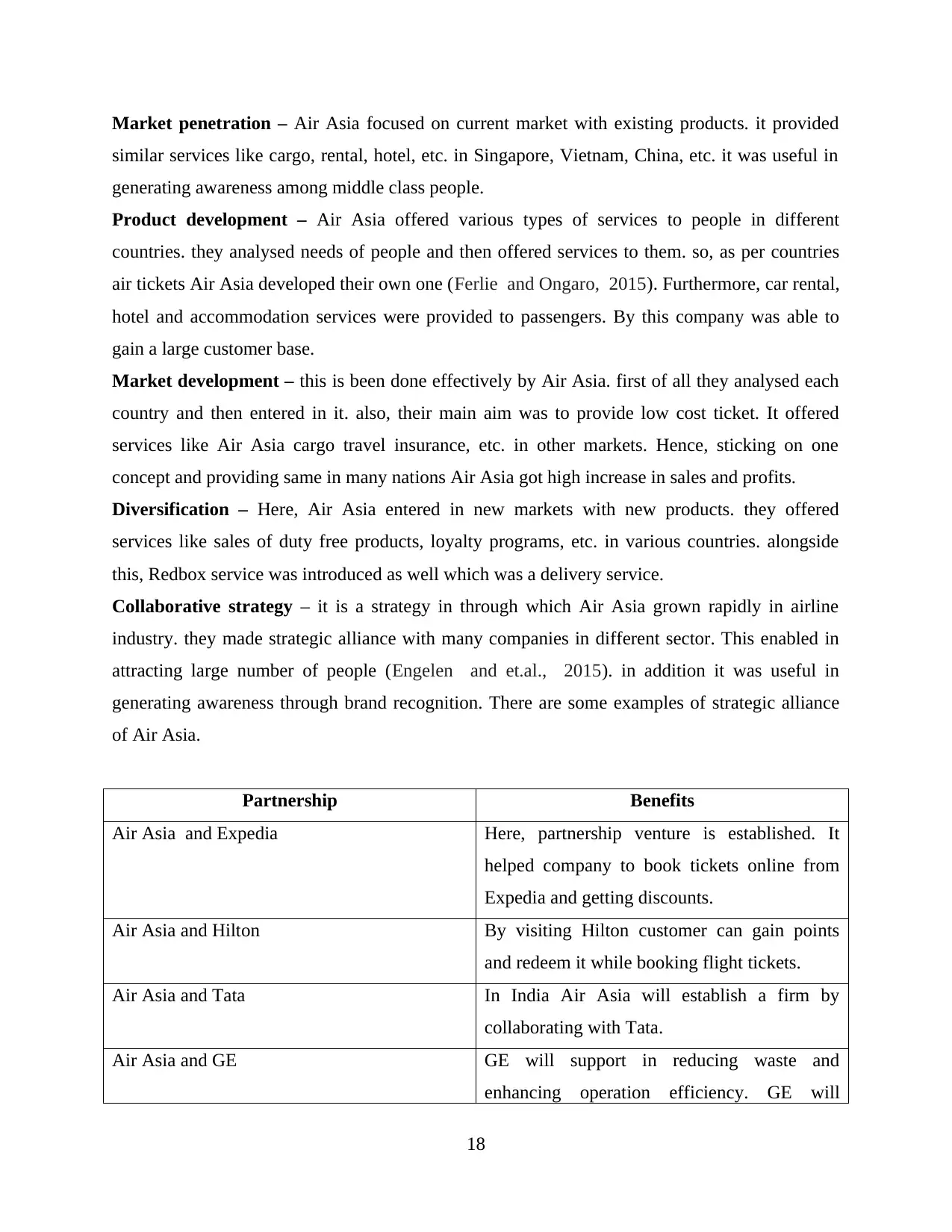
Market penetration – Air Asia focused on current market with existing products. it provided
similar services like cargo, rental, hotel, etc. in Singapore, Vietnam, China, etc. it was useful in
generating awareness among middle class people.
Product development – Air Asia offered various types of services to people in different
countries. they analysed needs of people and then offered services to them. so, as per countries
air tickets Air Asia developed their own one (Ferlie and Ongaro, 2015). Furthermore, car rental,
hotel and accommodation services were provided to passengers. By this company was able to
gain a large customer base.
Market development – this is been done effectively by Air Asia. first of all they analysed each
country and then entered in it. also, their main aim was to provide low cost ticket. It offered
services like Air Asia cargo travel insurance, etc. in other markets. Hence, sticking on one
concept and providing same in many nations Air Asia got high increase in sales and profits.
Diversification – Here, Air Asia entered in new markets with new products. they offered
services like sales of duty free products, loyalty programs, etc. in various countries. alongside
this, Redbox service was introduced as well which was a delivery service.
Collaborative strategy – it is a strategy in through which Air Asia grown rapidly in airline
industry. they made strategic alliance with many companies in different sector. This enabled in
attracting large number of people (Engelen and et.al., 2015). in addition it was useful in
generating awareness through brand recognition. There are some examples of strategic alliance
of Air Asia.
Partnership Benefits
Air Asia and Expedia Here, partnership venture is established. It
helped company to book tickets online from
Expedia and getting discounts.
Air Asia and Hilton By visiting Hilton customer can gain points
and redeem it while booking flight tickets.
Air Asia and Tata In India Air Asia will establish a firm by
collaborating with Tata.
Air Asia and GE GE will support in reducing waste and
enhancing operation efficiency. GE will
18
similar services like cargo, rental, hotel, etc. in Singapore, Vietnam, China, etc. it was useful in
generating awareness among middle class people.
Product development – Air Asia offered various types of services to people in different
countries. they analysed needs of people and then offered services to them. so, as per countries
air tickets Air Asia developed their own one (Ferlie and Ongaro, 2015). Furthermore, car rental,
hotel and accommodation services were provided to passengers. By this company was able to
gain a large customer base.
Market development – this is been done effectively by Air Asia. first of all they analysed each
country and then entered in it. also, their main aim was to provide low cost ticket. It offered
services like Air Asia cargo travel insurance, etc. in other markets. Hence, sticking on one
concept and providing same in many nations Air Asia got high increase in sales and profits.
Diversification – Here, Air Asia entered in new markets with new products. they offered
services like sales of duty free products, loyalty programs, etc. in various countries. alongside
this, Redbox service was introduced as well which was a delivery service.
Collaborative strategy – it is a strategy in through which Air Asia grown rapidly in airline
industry. they made strategic alliance with many companies in different sector. This enabled in
attracting large number of people (Engelen and et.al., 2015). in addition it was useful in
generating awareness through brand recognition. There are some examples of strategic alliance
of Air Asia.
Partnership Benefits
Air Asia and Expedia Here, partnership venture is established. It
helped company to book tickets online from
Expedia and getting discounts.
Air Asia and Hilton By visiting Hilton customer can gain points
and redeem it while booking flight tickets.
Air Asia and Tata In India Air Asia will establish a firm by
collaborating with Tata.
Air Asia and GE GE will support in reducing waste and
enhancing operation efficiency. GE will
18
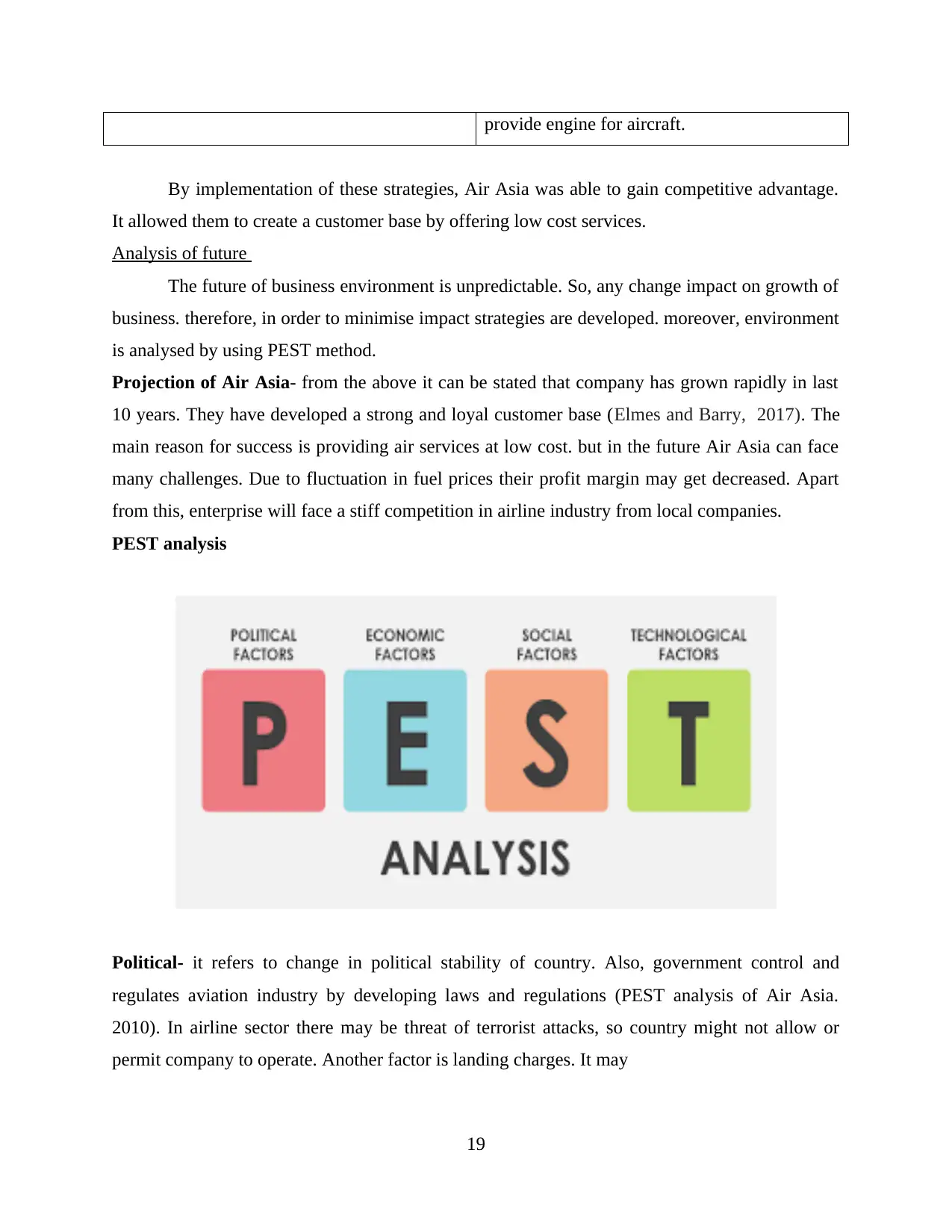
provide engine for aircraft.
By implementation of these strategies, Air Asia was able to gain competitive advantage.
It allowed them to create a customer base by offering low cost services.
Analysis of future
The future of business environment is unpredictable. So, any change impact on growth of
business. therefore, in order to minimise impact strategies are developed. moreover, environment
is analysed by using PEST method.
Projection of Air Asia- from the above it can be stated that company has grown rapidly in last
10 years. They have developed a strong and loyal customer base (Elmes and Barry, 2017). The
main reason for success is providing air services at low cost. but in the future Air Asia can face
many challenges. Due to fluctuation in fuel prices their profit margin may get decreased. Apart
from this, enterprise will face a stiff competition in airline industry from local companies.
PEST analysis
Political- it refers to change in political stability of country. Also, government control and
regulates aviation industry by developing laws and regulations (PEST analysis of Air Asia.
2010). In airline sector there may be threat of terrorist attacks, so country might not allow or
permit company to operate. Another factor is landing charges. It may
19
By implementation of these strategies, Air Asia was able to gain competitive advantage.
It allowed them to create a customer base by offering low cost services.
Analysis of future
The future of business environment is unpredictable. So, any change impact on growth of
business. therefore, in order to minimise impact strategies are developed. moreover, environment
is analysed by using PEST method.
Projection of Air Asia- from the above it can be stated that company has grown rapidly in last
10 years. They have developed a strong and loyal customer base (Elmes and Barry, 2017). The
main reason for success is providing air services at low cost. but in the future Air Asia can face
many challenges. Due to fluctuation in fuel prices their profit margin may get decreased. Apart
from this, enterprise will face a stiff competition in airline industry from local companies.
PEST analysis
Political- it refers to change in political stability of country. Also, government control and
regulates aviation industry by developing laws and regulations (PEST analysis of Air Asia.
2010). In airline sector there may be threat of terrorist attacks, so country might not allow or
permit company to operate. Another factor is landing charges. It may
19
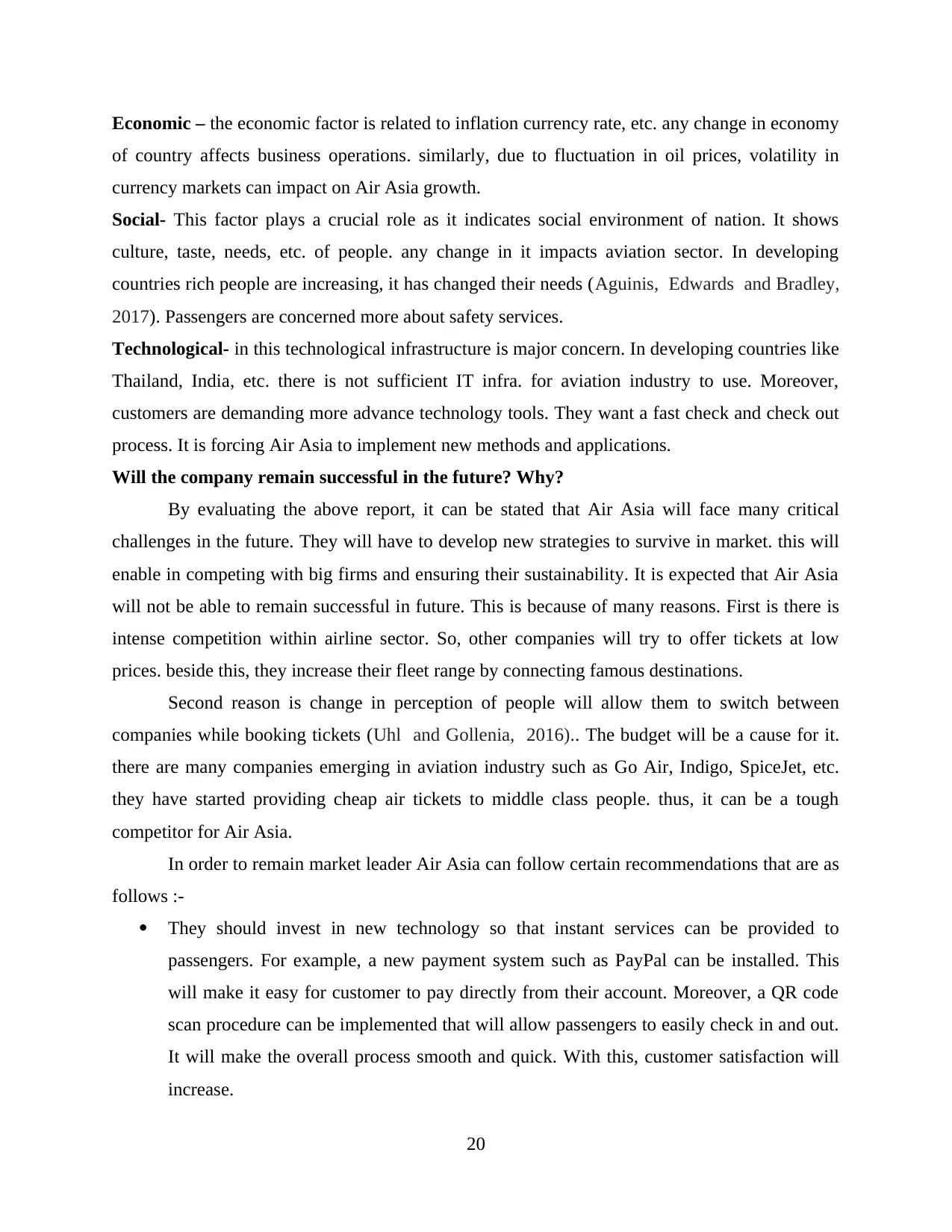
Economic – the economic factor is related to inflation currency rate, etc. any change in economy
of country affects business operations. similarly, due to fluctuation in oil prices, volatility in
currency markets can impact on Air Asia growth.
Social- This factor plays a crucial role as it indicates social environment of nation. It shows
culture, taste, needs, etc. of people. any change in it impacts aviation sector. In developing
countries rich people are increasing, it has changed their needs (Aguinis, Edwards and Bradley,
2017). Passengers are concerned more about safety services.
Technological- in this technological infrastructure is major concern. In developing countries like
Thailand, India, etc. there is not sufficient IT infra. for aviation industry to use. Moreover,
customers are demanding more advance technology tools. They want a fast check and check out
process. It is forcing Air Asia to implement new methods and applications.
Will the company remain successful in the future? Why?
By evaluating the above report, it can be stated that Air Asia will face many critical
challenges in the future. They will have to develop new strategies to survive in market. this will
enable in competing with big firms and ensuring their sustainability. It is expected that Air Asia
will not be able to remain successful in future. This is because of many reasons. First is there is
intense competition within airline sector. So, other companies will try to offer tickets at low
prices. beside this, they increase their fleet range by connecting famous destinations.
Second reason is change in perception of people will allow them to switch between
companies while booking tickets (Uhl and Gollenia, 2016).. The budget will be a cause for it.
there are many companies emerging in aviation industry such as Go Air, Indigo, SpiceJet, etc.
they have started providing cheap air tickets to middle class people. thus, it can be a tough
competitor for Air Asia.
In order to remain market leader Air Asia can follow certain recommendations that are as
follows :-
They should invest in new technology so that instant services can be provided to
passengers. For example, a new payment system such as PayPal can be installed. This
will make it easy for customer to pay directly from their account. Moreover, a QR code
scan procedure can be implemented that will allow passengers to easily check in and out.
It will make the overall process smooth and quick. With this, customer satisfaction will
increase.
20
of country affects business operations. similarly, due to fluctuation in oil prices, volatility in
currency markets can impact on Air Asia growth.
Social- This factor plays a crucial role as it indicates social environment of nation. It shows
culture, taste, needs, etc. of people. any change in it impacts aviation sector. In developing
countries rich people are increasing, it has changed their needs (Aguinis, Edwards and Bradley,
2017). Passengers are concerned more about safety services.
Technological- in this technological infrastructure is major concern. In developing countries like
Thailand, India, etc. there is not sufficient IT infra. for aviation industry to use. Moreover,
customers are demanding more advance technology tools. They want a fast check and check out
process. It is forcing Air Asia to implement new methods and applications.
Will the company remain successful in the future? Why?
By evaluating the above report, it can be stated that Air Asia will face many critical
challenges in the future. They will have to develop new strategies to survive in market. this will
enable in competing with big firms and ensuring their sustainability. It is expected that Air Asia
will not be able to remain successful in future. This is because of many reasons. First is there is
intense competition within airline sector. So, other companies will try to offer tickets at low
prices. beside this, they increase their fleet range by connecting famous destinations.
Second reason is change in perception of people will allow them to switch between
companies while booking tickets (Uhl and Gollenia, 2016).. The budget will be a cause for it.
there are many companies emerging in aviation industry such as Go Air, Indigo, SpiceJet, etc.
they have started providing cheap air tickets to middle class people. thus, it can be a tough
competitor for Air Asia.
In order to remain market leader Air Asia can follow certain recommendations that are as
follows :-
They should invest in new technology so that instant services can be provided to
passengers. For example, a new payment system such as PayPal can be installed. This
will make it easy for customer to pay directly from their account. Moreover, a QR code
scan procedure can be implemented that will allow passengers to easily check in and out.
It will make the overall process smooth and quick. With this, customer satisfaction will
increase.
20
Secure Best Marks with AI Grader
Need help grading? Try our AI Grader for instant feedback on your assignments.
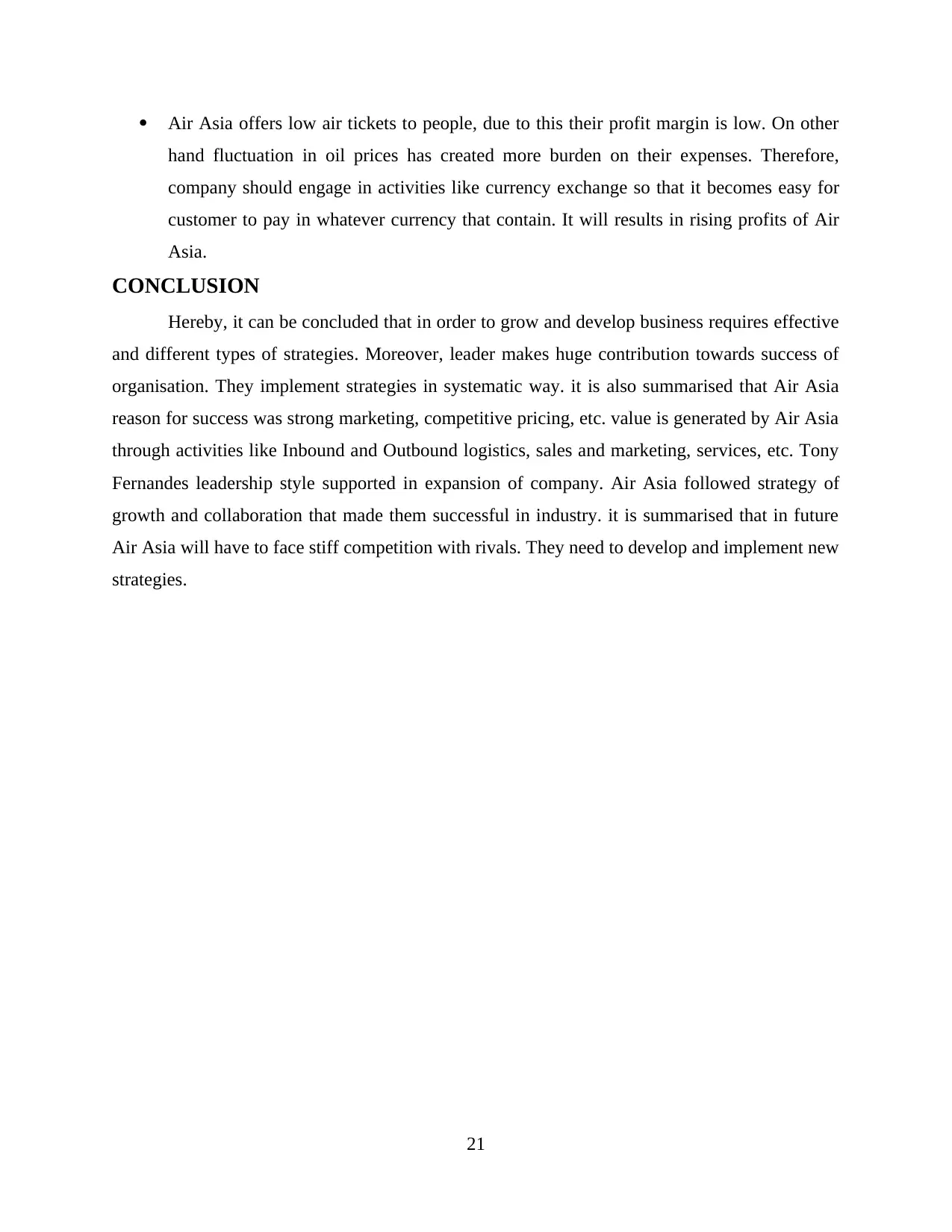
Air Asia offers low air tickets to people, due to this their profit margin is low. On other
hand fluctuation in oil prices has created more burden on their expenses. Therefore,
company should engage in activities like currency exchange so that it becomes easy for
customer to pay in whatever currency that contain. It will results in rising profits of Air
Asia.
CONCLUSION
Hereby, it can be concluded that in order to grow and develop business requires effective
and different types of strategies. Moreover, leader makes huge contribution towards success of
organisation. They implement strategies in systematic way. it is also summarised that Air Asia
reason for success was strong marketing, competitive pricing, etc. value is generated by Air Asia
through activities like Inbound and Outbound logistics, sales and marketing, services, etc. Tony
Fernandes leadership style supported in expansion of company. Air Asia followed strategy of
growth and collaboration that made them successful in industry. it is summarised that in future
Air Asia will have to face stiff competition with rivals. They need to develop and implement new
strategies.
21
hand fluctuation in oil prices has created more burden on their expenses. Therefore,
company should engage in activities like currency exchange so that it becomes easy for
customer to pay in whatever currency that contain. It will results in rising profits of Air
Asia.
CONCLUSION
Hereby, it can be concluded that in order to grow and develop business requires effective
and different types of strategies. Moreover, leader makes huge contribution towards success of
organisation. They implement strategies in systematic way. it is also summarised that Air Asia
reason for success was strong marketing, competitive pricing, etc. value is generated by Air Asia
through activities like Inbound and Outbound logistics, sales and marketing, services, etc. Tony
Fernandes leadership style supported in expansion of company. Air Asia followed strategy of
growth and collaboration that made them successful in industry. it is summarised that in future
Air Asia will have to face stiff competition with rivals. They need to develop and implement new
strategies.
21
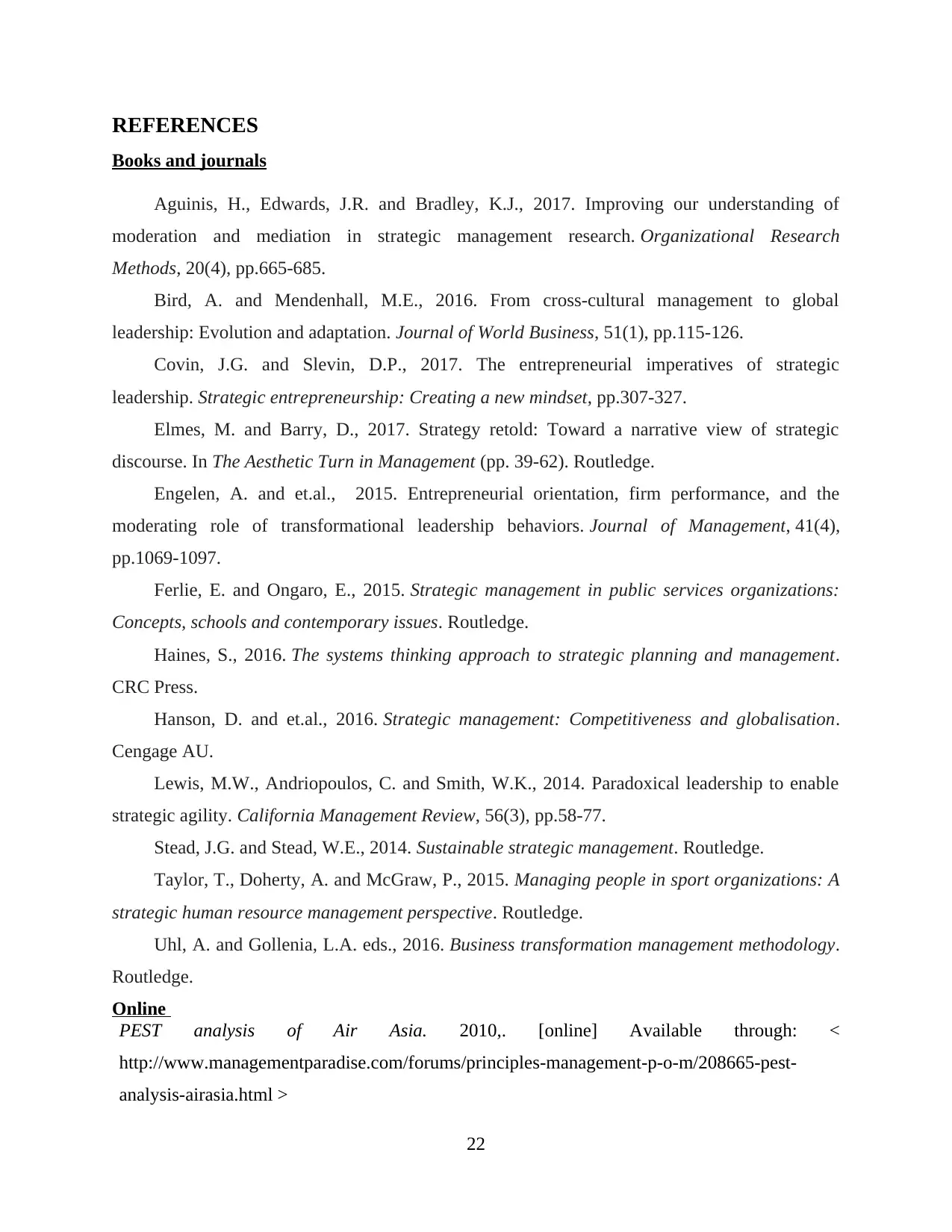
REFERENCES
Books and journals
Aguinis, H., Edwards, J.R. and Bradley, K.J., 2017. Improving our understanding of
moderation and mediation in strategic management research. Organizational Research
Methods, 20(4), pp.665-685.
Bird, A. and Mendenhall, M.E., 2016. From cross-cultural management to global
leadership: Evolution and adaptation. Journal of World Business, 51(1), pp.115-126.
Covin, J.G. and Slevin, D.P., 2017. The entrepreneurial imperatives of strategic
leadership. Strategic entrepreneurship: Creating a new mindset, pp.307-327.
Elmes, M. and Barry, D., 2017. Strategy retold: Toward a narrative view of strategic
discourse. In The Aesthetic Turn in Management (pp. 39-62). Routledge.
Engelen, A. and et.al., 2015. Entrepreneurial orientation, firm performance, and the
moderating role of transformational leadership behaviors. Journal of Management, 41(4),
pp.1069-1097.
Ferlie, E. and Ongaro, E., 2015. Strategic management in public services organizations:
Concepts, schools and contemporary issues. Routledge.
Haines, S., 2016. The systems thinking approach to strategic planning and management.
CRC Press.
Hanson, D. and et.al., 2016. Strategic management: Competitiveness and globalisation.
Cengage AU.
Lewis, M.W., Andriopoulos, C. and Smith, W.K., 2014. Paradoxical leadership to enable
strategic agility. California Management Review, 56(3), pp.58-77.
Stead, J.G. and Stead, W.E., 2014. Sustainable strategic management. Routledge.
Taylor, T., Doherty, A. and McGraw, P., 2015. Managing people in sport organizations: A
strategic human resource management perspective. Routledge.
Uhl, A. and Gollenia, L.A. eds., 2016. Business transformation management methodology.
Routledge.
Online
PEST analysis of Air Asia. 2010,. [online] Available through: <
http://www.managementparadise.com/forums/principles-management-p-o-m/208665-pest-
analysis-airasia.html >
22
Books and journals
Aguinis, H., Edwards, J.R. and Bradley, K.J., 2017. Improving our understanding of
moderation and mediation in strategic management research. Organizational Research
Methods, 20(4), pp.665-685.
Bird, A. and Mendenhall, M.E., 2016. From cross-cultural management to global
leadership: Evolution and adaptation. Journal of World Business, 51(1), pp.115-126.
Covin, J.G. and Slevin, D.P., 2017. The entrepreneurial imperatives of strategic
leadership. Strategic entrepreneurship: Creating a new mindset, pp.307-327.
Elmes, M. and Barry, D., 2017. Strategy retold: Toward a narrative view of strategic
discourse. In The Aesthetic Turn in Management (pp. 39-62). Routledge.
Engelen, A. and et.al., 2015. Entrepreneurial orientation, firm performance, and the
moderating role of transformational leadership behaviors. Journal of Management, 41(4),
pp.1069-1097.
Ferlie, E. and Ongaro, E., 2015. Strategic management in public services organizations:
Concepts, schools and contemporary issues. Routledge.
Haines, S., 2016. The systems thinking approach to strategic planning and management.
CRC Press.
Hanson, D. and et.al., 2016. Strategic management: Competitiveness and globalisation.
Cengage AU.
Lewis, M.W., Andriopoulos, C. and Smith, W.K., 2014. Paradoxical leadership to enable
strategic agility. California Management Review, 56(3), pp.58-77.
Stead, J.G. and Stead, W.E., 2014. Sustainable strategic management. Routledge.
Taylor, T., Doherty, A. and McGraw, P., 2015. Managing people in sport organizations: A
strategic human resource management perspective. Routledge.
Uhl, A. and Gollenia, L.A. eds., 2016. Business transformation management methodology.
Routledge.
Online
PEST analysis of Air Asia. 2010,. [online] Available through: <
http://www.managementparadise.com/forums/principles-management-p-o-m/208665-pest-
analysis-airasia.html >
22

23
1 out of 25
Related Documents
Your All-in-One AI-Powered Toolkit for Academic Success.
+13062052269
info@desklib.com
Available 24*7 on WhatsApp / Email
![[object Object]](/_next/static/media/star-bottom.7253800d.svg)
Unlock your academic potential
© 2024 | Zucol Services PVT LTD | All rights reserved.





